 | E-mail to Birds Korea |
 | KWBS |
in the Region
 | The Oriental Bird Club |
 | BirdLife International (Asia) |
April
One of the very best birdwatching months! Cold days and nights (lowest day maxima of ca 12°C) gradually warm through the month (reaching the low 20s°C by month's end), and dry spells interspersed with 1-2 days of heavy rain and stormy conditions produce great birding towards month's end.
Early in the month, late Hooded Crane move through while shorebird numbers and diversity start to build up, with up to 200 000 shorebirds in the Saemangeum area by the end of the month, including up to 60 000 Great Knot, and small numbers of the globally-endangered Nordmann's Greenshank and Spoon-billed Sandpiper. Other Korean specialities, include Chinese Egret from mid-month, and Black-faced Spoonbill in small groups along the west coast. This latter species only has a world population of around 1400! In early April, species like Brown-headed Thrush and Japanese Robin occur regularly in very small numbers in the far southwest and southeast, while mid-April sees the first large passerine arrivals and spring overshoots, with good counts of many species like Blue-and-white, Narcissus and Yellow-rumped Flycatchers, and Tristram's and Yellow-browed Buntings. Late in the month, 100 or more species a day are possible on the outer islands like Heuksan and Gageo in the far south, Eocheong off Gunsan, and Socheong to the northwest.
Highlights in April have included several firsts and many unusual records for Korea, including Caspian Tern in the Nakdong estuary in 2001, Ferruginous Flycatcher and Eurasian Crag Martin on Eocheong Island in 2002, Northern House Martin and Red-breasted Flycatcher on Eocheong in 2003, and a Paddyfield Warbler on Hong Island in 2004.
(The following records are a compilation of our own sightings and records sent in by other observers. As well as being posted on the Birds Korea website(s), selected records are also forwarded to other Korean-language birding websites; records of threatened species are arranged and forwarded to Birdlife International and national authorities when appropriate; flag images and records are passed to bodies responsible for their coordination throughout the flyway; and all records sent to us are used to compile annual reports and to support the evolving understanding of the status of many of Korea’s birds.)
Mokpo Namhang Tidal flat, April 30
While the tidal flat was completely flooded by the morning high tide up to the wall along the sidewalk with only about 30 Eurasian Widgeon and few CommonTeal on the water all other birds roosted and feeded in the two wall-enclosed areas beside the tidal flat.
Over 350 Dunlin, 107 Red-necked Stint, 87 Bar-tailed Godwit (3 flagged), 37 Ruddy Turnstone, 7 Common Greenshank, 5 Grey-tailed Tattler, 3 Terek Sandpiper, 5 Sharp-tailed Sandpiper, 60+ Kentish, 7 Little-ringed and 5 Grey Plover as well as 17 Whrimbel and 1 Great Knot (a few days earlier up to 5) were seen. With raising water in this location about 50 Common Teal, 13 Spot-billed Duck and 3 Northern Shoveler along with 2 Little Tern and 3 Grey Heron shared the little remaining sand banks with the shorebirds.
In the course of his research work Dr. Kim Seok-Yee shared the very positive news of the discovery of 3 Kentish Plover (3 eggs each) and one Little-ringed Plover (4 eggs) nests.
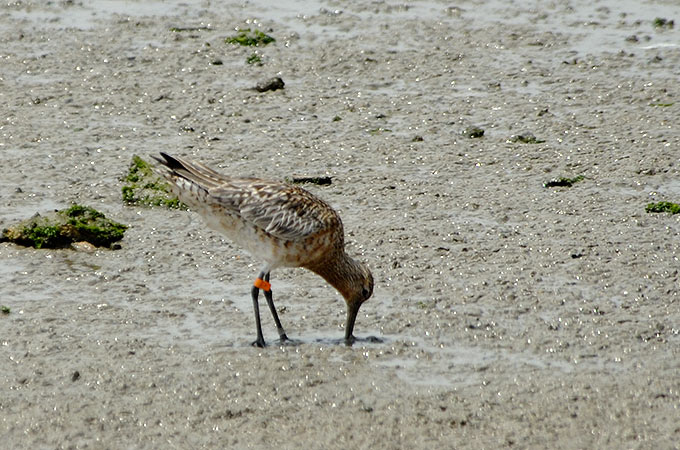
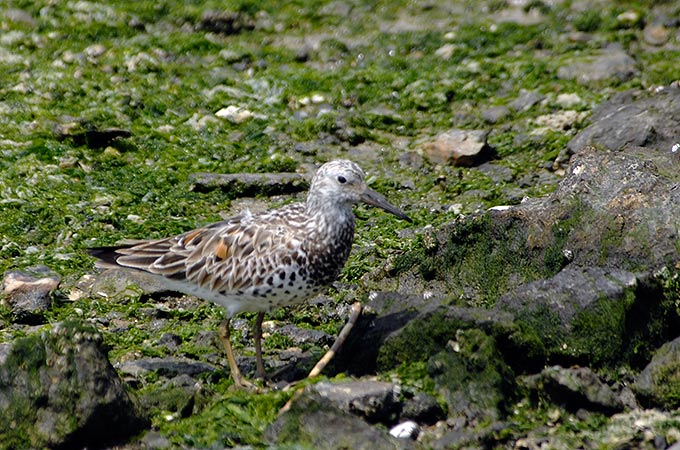
Jeongbalsan, Ilsan, April 29
A single male Yellow-rumped Flycatcher was well observed.
Saemangeum, April 28
In increasingly warm sunshine, several teams covered much of the Saemangeum system. In several areas, masses of dead shellfish littered the surface, apparently coincidental with several days of greatly lowered water levels and almost no tidal movement within the system, following the third anniversary of the seawall closure (April 21, 2006). Most bird-rich was the airport area in the outer Mangyeung, with c 16,000 shorebirds in one stretch (mostly Dunlin [8,000] and Great Knot [7,000], including several Chongmin Dao leg-flagged birds, two Broad-billed Sandpiper and 4 or 5 Grey-tailed Tattler). Obvious highlight there, however, was the discovery of three Spoon-billed Sandpiper (two in full-breeding plumage, one in intermediate plumage) in among a group of 500 shorebirds, with a feeding Chinese Egret behind.
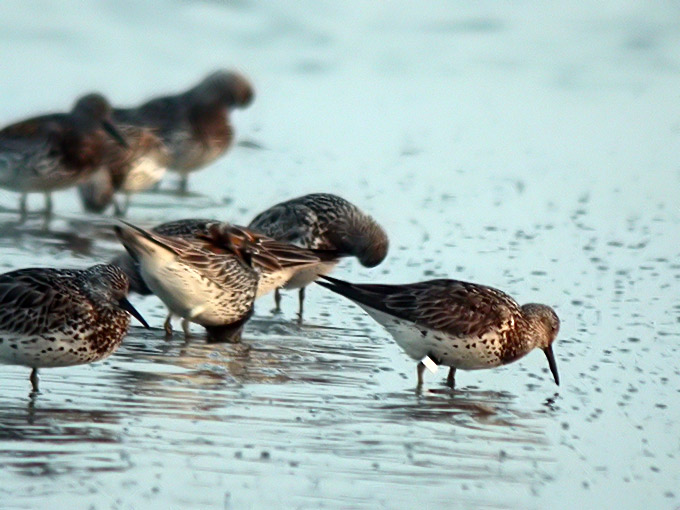
Jeongbalsan, Ilsan, April 28
Six Black-faced Bunting were seen next to a parking lot. A Yellow-browed Warbler was spotted drinking in a drainage ditch in a scrubby area. One Asian Stubtail was in the same spot, and several others were heard nearby. The highlight was a Eurasian Wryneck hiding in a large scrubby bush. It was calling noisily, making a repeated metallic ‘creaking’. It was briefly but well observed.
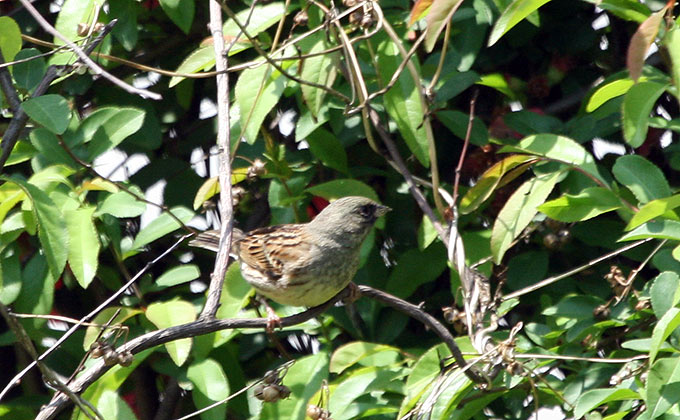
Eocheong Island and Ferry, April 27
With warm sunshine and only patchy morning mist, only a couple of hours in the field before catching the boat back to the mainland and the SSMP study site. Highlights on Eocheong included several Wryneck (with three together in the quarry, including one in song), the female Pied Harrier and one Citrine Wagtail still, and 2 Japanese Grosbeak seen briefly in flight. From the ferry, 12 Ancient Murrelet, 4+ Streaked Shearwater, two Red-throated Loon and at least one Grey Nightjar, while within Saemangeum, water levels appeared massively lower than one week before.
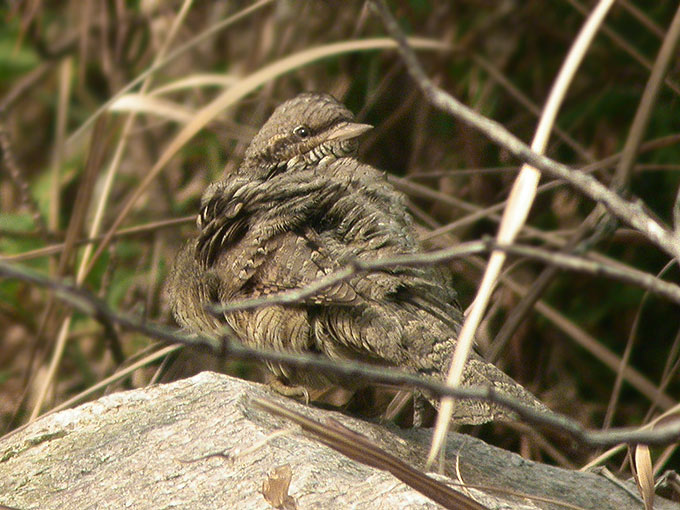
Gwangyang, April 27
I had a few hours of time so I decided to head to some nearby fields to watch the Common Pheasants. While watching them a White-rumped Swift put in a short appearance and I noted good numbers of Wood Sandpiper, Little Ringed Plover and Common Snipe as well as many more 'usual' species. On a nearby rocky shore were very good numbers of Ruddy Turnstone joined by a scattering of Terek Sandpiper.
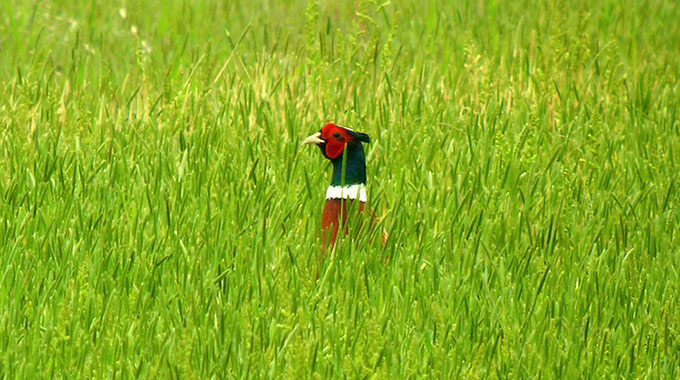
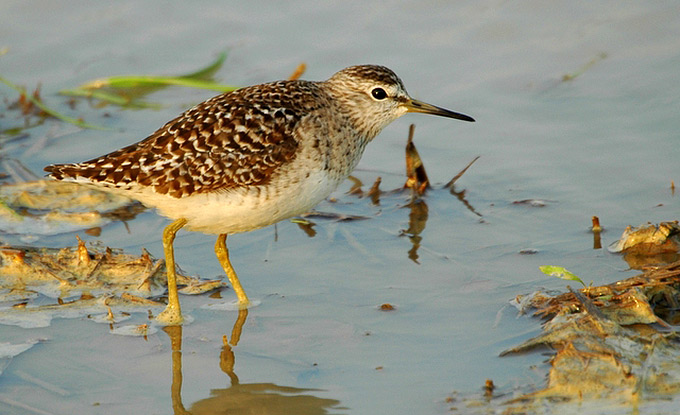
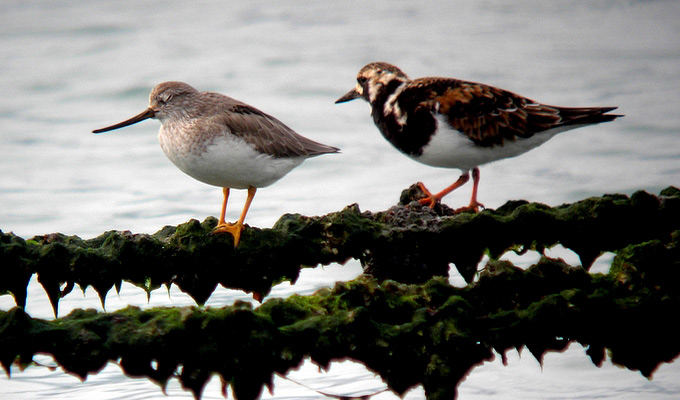
Eocheong Island, April 26
Overcast over night, followed by long sunny periods and a gradually moderating wind through the day, allowed for more birds to be found. While over 90 species were logged, the numbers of most species seemed very low compared to previous years. Most numerous species (seen by NM) for example included Grey-faced Buzzard (with a single group of 30 arriving at dusk), Siskin (140), Brambling (50), Olive-backed Pipit (40+), Coal Tit (40), Pale Thrush (30), Barn Swallow (25+), Siberian Stonechat (25), and Black-faced (25) and Little Buntings (20), while species such as Siberian Blue Robin (4), Siberian Rubythroat (4), and Narcissus (3) and Yellow-rumped Flycatchers (1) seemed remarkably scarce considering the conditions. Species of especial note for the day included a male and a female Pied Harrier (the latter spendng time hunting over the southern end of the island), single Marsh Sandpiper, two Northern House Martin, probable Latham's and one or two Pintail Snipe, one or possibly two female Citrine Wagtail, single male Chestnut-cheeked and Red-billed Starlings, and two Yellow-breasted Bunting. Further colour was also provided by several Common Kingfisher and at least six Hoopoe (including birds watched both arriving and departing the island).
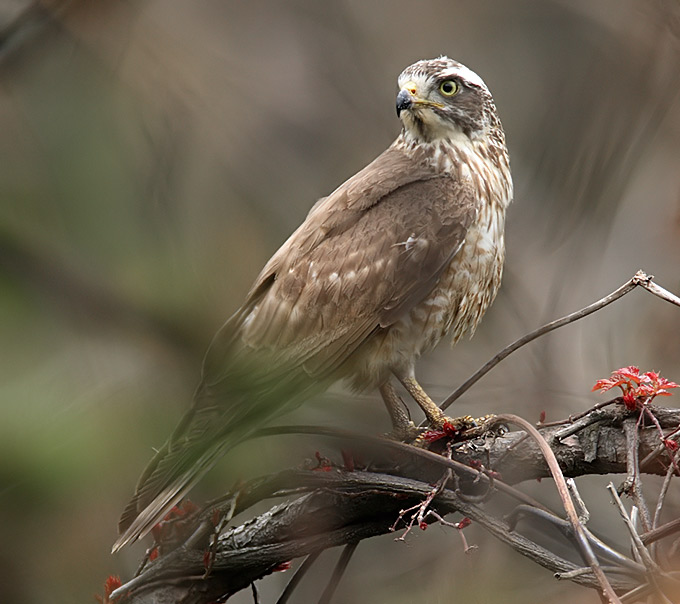
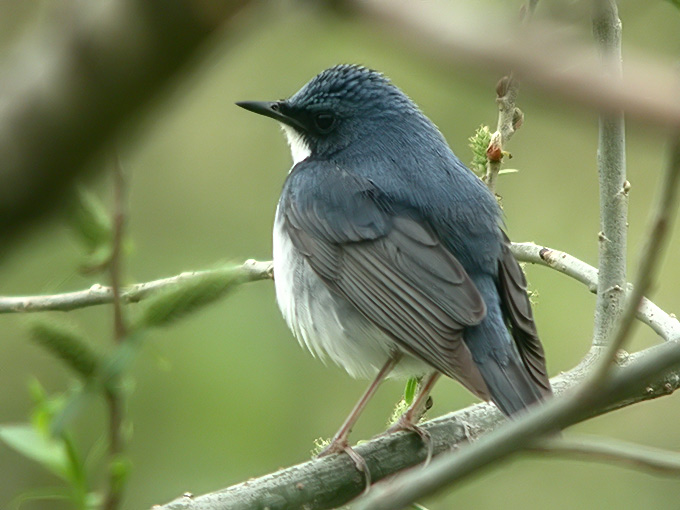
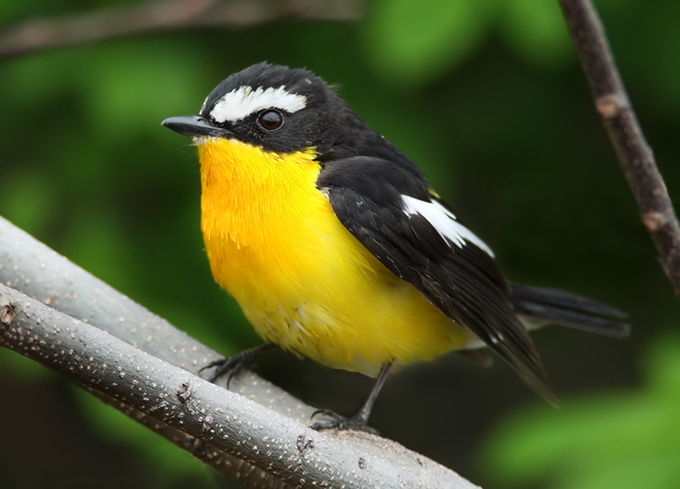
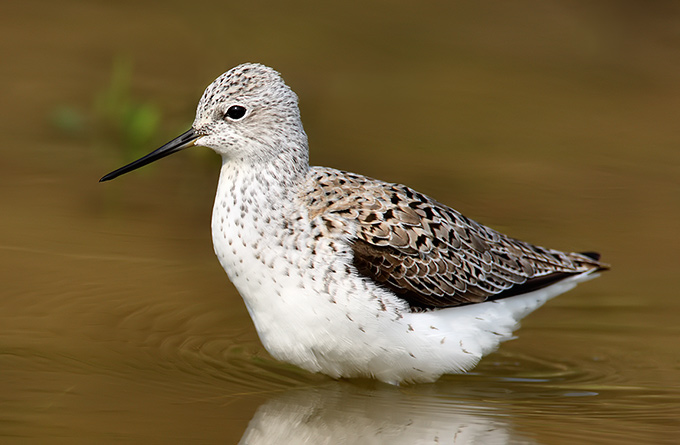
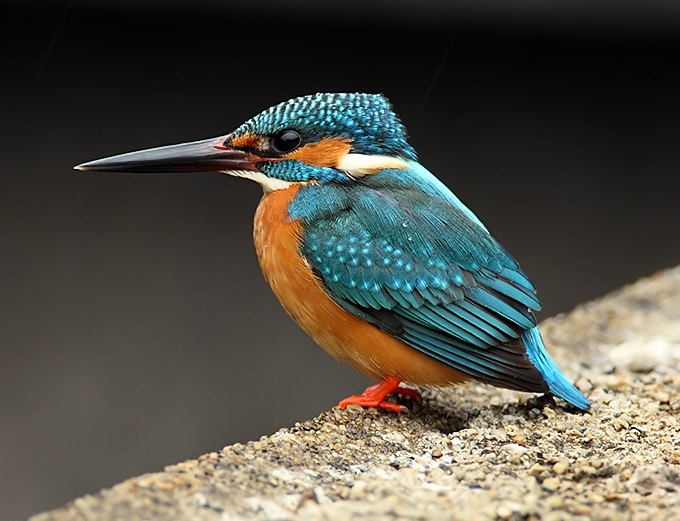
Yanggu x river, farmland and forest, April 26
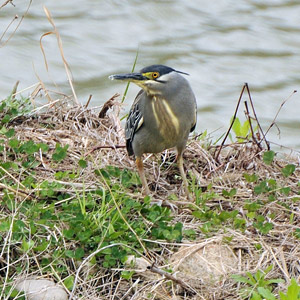
Photo © Barry Heinrich
There have been some intersting movements of birds in Yanggu in the last month or so. Most of the winter waterbirds have left now with only a few stragglers in the area. I saw 2 Mallards and 5 Common Teals along the river today. Early in April there were still more than 200 White-fronted Geese around here. On April 24 I saw 2 White-fronted Geese and a Bean Goose in a freshly tilled and flooded rice field.
Passage migrant passerines have been seen as well. Today there were four Red-throated Pipits, more than 20 White Wagtails Motacilla alba ocularis and a Wood Sandpiper along the river. Buff-bellied Pipits were also present in significant numbers. Siskins have been seen eating the seeds from the dry pods of last years Oenathera lamarkiana along the river bank. Summer visitors have also arrives including Korean Bush Warbler, Pale Thrushes, White Thrushes and Barn Swallows. There were 2 Red-rumped Swallows amongst the flocks of swallows along the river today. I heard Oriental Scops Owls calling last weekend as well.
Black-faced Buntings were seen along the river today, but Rustic Buntings appear to have left the area. Yellow-throated Buntings have moved in the the forest on the hills for summer and I assume to breed.
Spring breeding has also commenced here. Grey Herons and Great Egrets have occupied the same nesting site here as in previous years. Striated Herons arrive here this week. Long-billed Plovers, Little Ringed Plovers, Green Sandpipers and Common Sandpipers are very active along river amongst the rocks. Common Kingfishers and Grey Wagtails were also seen. Spring is always interesting for birding here.
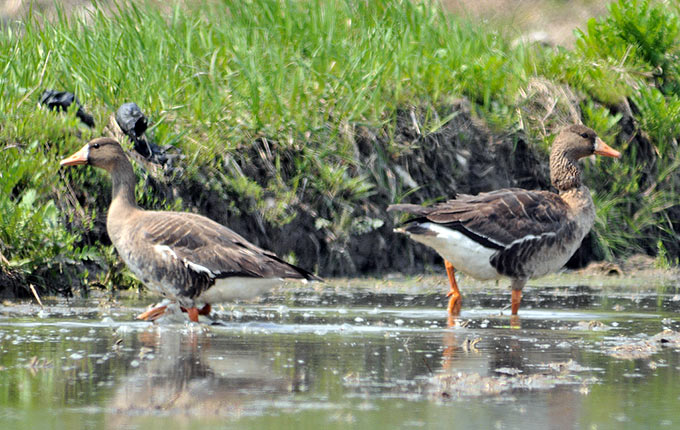
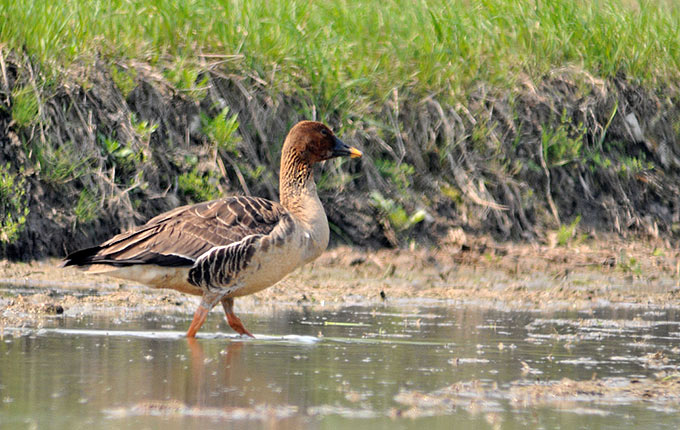
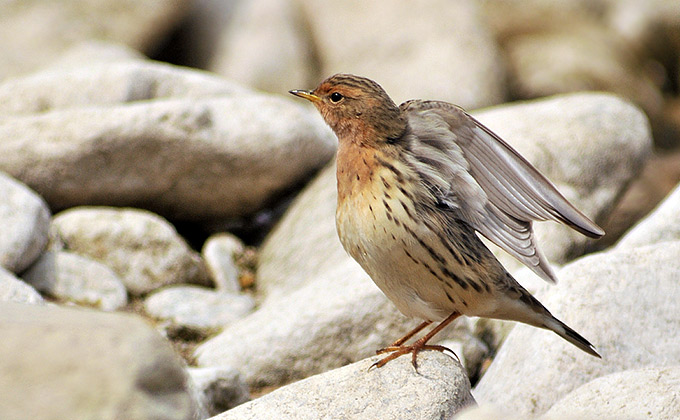
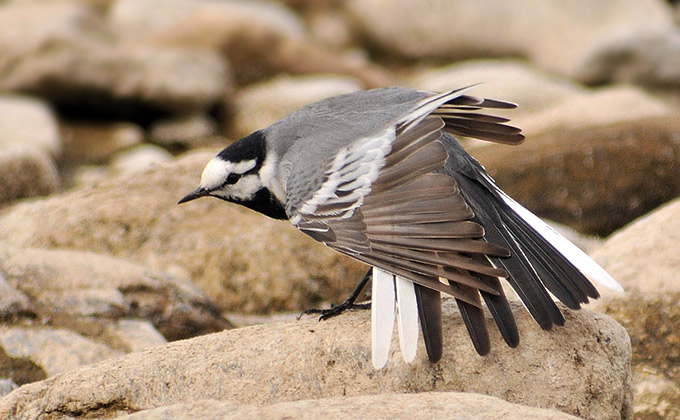
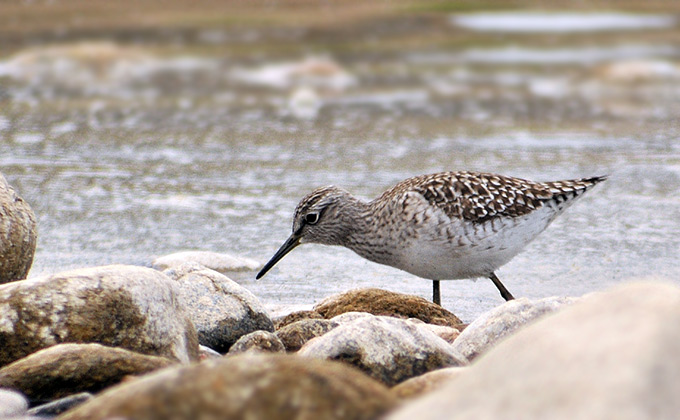
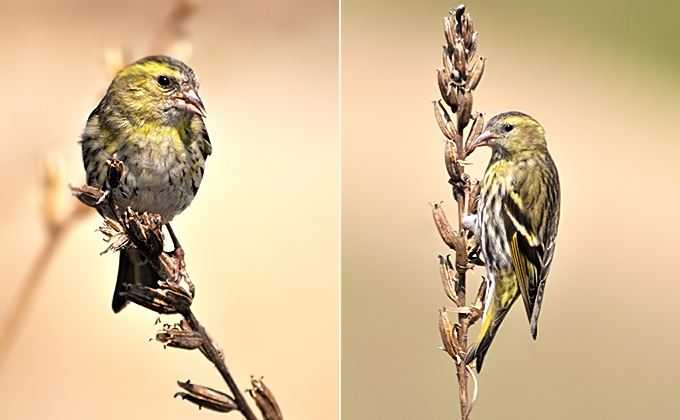
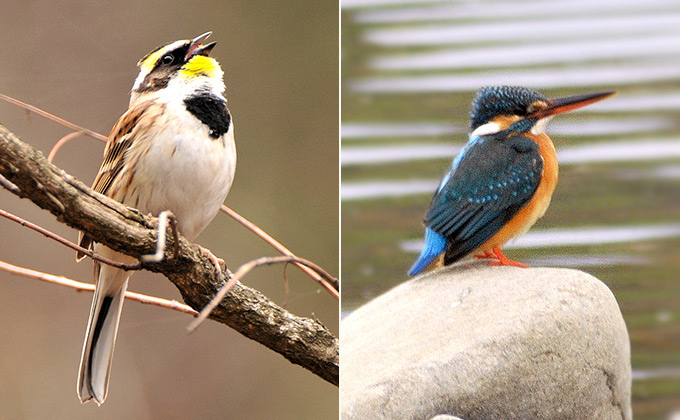
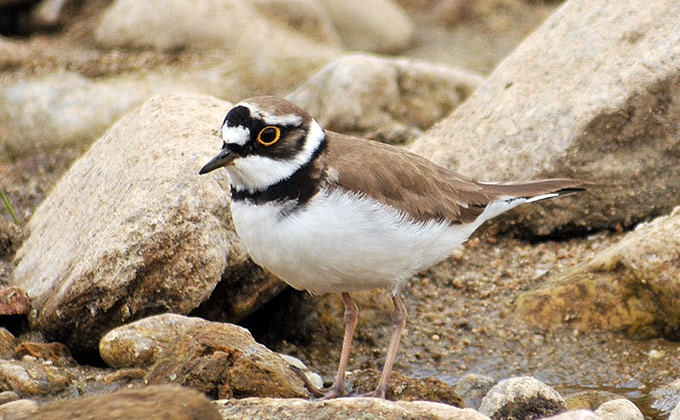
Eocheong Island, April 25
A day of very strong winds (with Beaufort Force 6-7 northwesterlys through most of the day), followed by an evening thunderstorm and rain. Despite the difficult weather conditions, several excellent species were found, including the Citrine Wagtail still, a male Black Redstart (glimpsed by Robin Newlin only), at least 2 (and possibly up to 6?) Himalayan Swiftlet (Fred van Gessel and Geoff Styles only). Further species of note included a male Bluethroat, 2 Chinese Grosbeak and a flyover Forest Wagtail (heard only) in the evening.
Jeongbalsan, Ilsan, April 25
Barn Swallows have returned to Ilsan, with several seen overhead at any time. The Olive-backed Pipits appear to have moved on – they were not seen all week. About a dozen Tristrams’s Bunting were seen feeding at the forest’s edge. A tree held a large mixed flock of about 40 Eurasian Siskin and Tree Sparrow. Several female Red-flanked Bluetail were seen nearby. A dead Temminck’s Mole was seen, perhaps killed by a cat that inhabits the area.
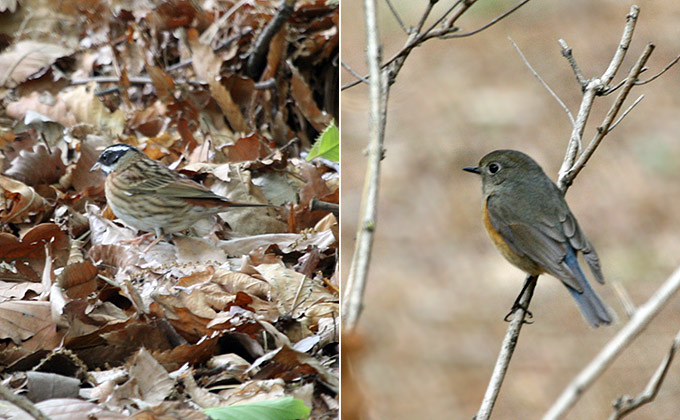
Eocheong Island, April 24
Sunny, with winds moderating overnight, to become light southwesterlies. Despite this, the boat back to the mainland was cancelled. Many of the same birds as yesterday and the day before, with the addition of a Greater Short-toed Lark (while regular on west coast islands, this species is still very rare on the mainland) and a female Citrine Wagtail soon taking up territory at the reservoir. Other species of especial interest included a cumatilis Blue-and-White Flycatcher, an immature male Narcissus with stong green tones to the mantle (though still much less green than one seen but not photographed by Robin Newlin on 23rd), a simplex Japanese White-eye and a Red-billed Starling, while most numerous migrants seen during the day included e.g. Korean Bush Warbler (20), Asian Stubtail (20) and Dusky Warbler (30).
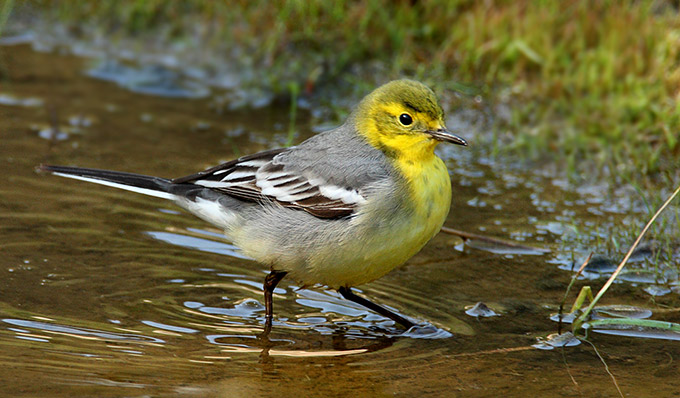
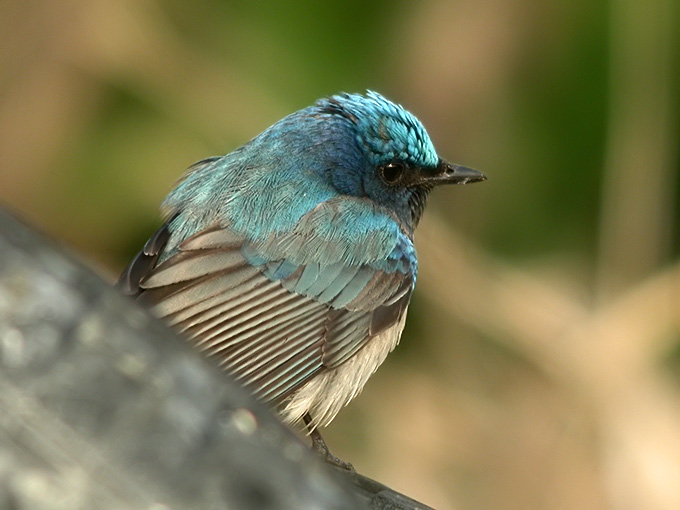
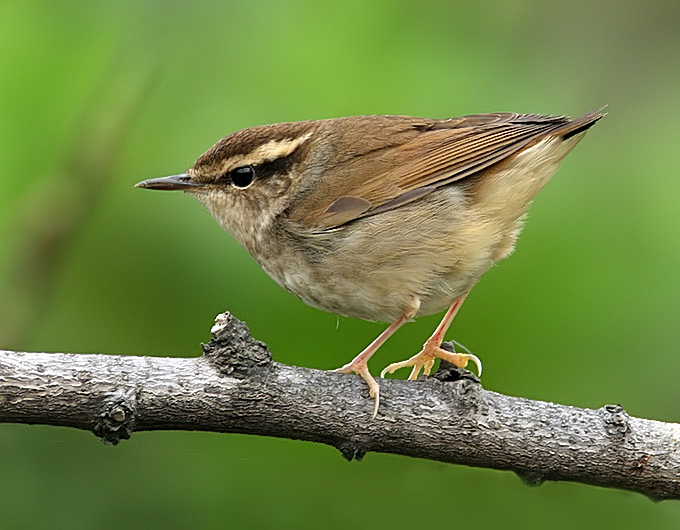
Eocheong Island, April 23
Starting overcast, then brightening with a cold and strong north to northwesterly wind. Hard birding conditions, with only 75 species logged for the day. Good numbers of thrushes grounded (with for example 50+ Dusky and 40+ Pale, single Grey and 7+ Brown-headed), with only small numbers of warblers and flycatcher. Highlights for the day included 2 Northern House Martin (along with 4+ Asian House Martin), and possibly 2 baicalensis White Wagtail.
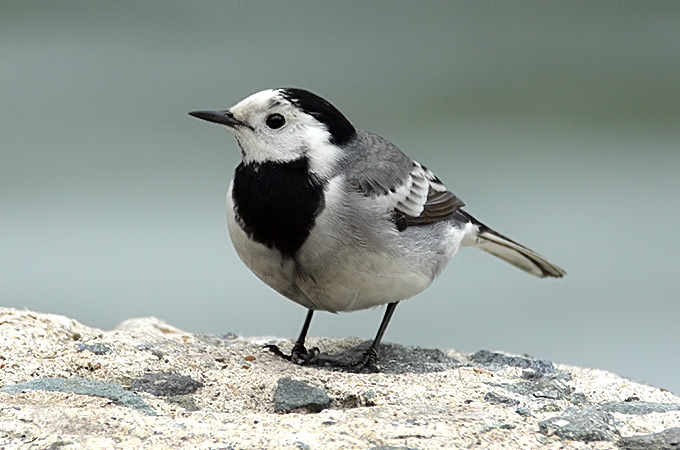
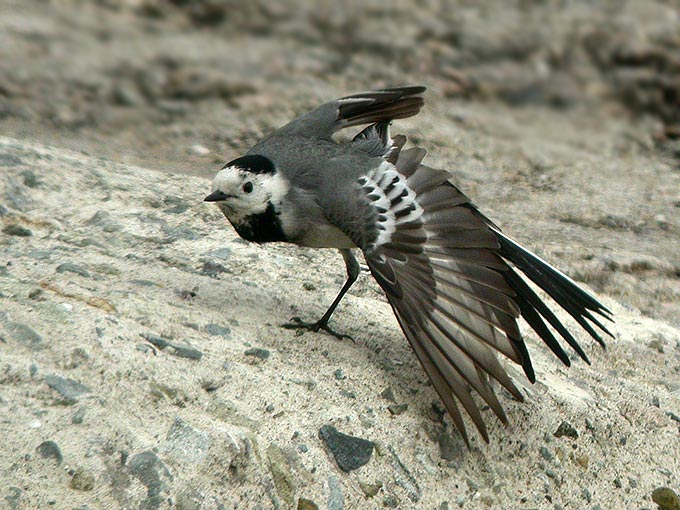
Uiwang, April 23
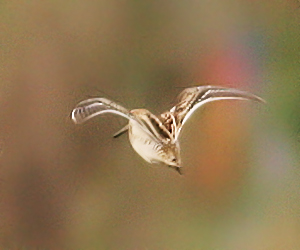
Photo © Tim Edelsten
Spring at the reservoir has brought a Schrenck's Bittern- which seems 5 or 6 days earlier than is usual: also fresh in, 3 Common Greenshank, a Common Moorhen, and plentiful Barn Swallows. Three Wood Sandpipers included a breeding-plumaged individual, whose streaked crown and breast, barred flanks, brighter colored legs and bill base, and very speckled upperparts contrasted sharply with the dull brown washed winter-plumaged birds it was with. A Common Kingfisher was seen repeatedly plunging for fish at his usual perch. Four Common Snipe frequented the newly flooded ricefields: one appeared to have a harsher "kietsch" call than the others but analysis of all images showed the clear dark grey and white underwing covert pattern typical of Common. Great-Crested Grebes and Coots are preparing to nest: Grey Herons are likewise collecting dead reed stems.
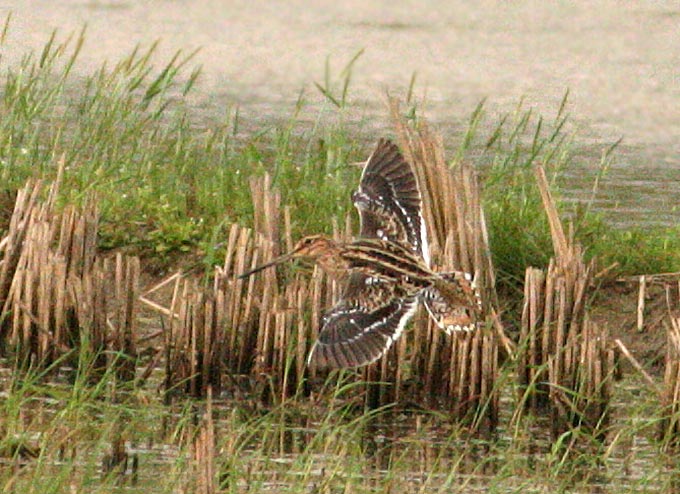
Eocheong Island, April 22
Overcast overnight, with rain showers in the morning, followed by heavy rain from 5PM onwards, with light southwesterly winds throughout. In total, c 80 species logged during the day. Highlights included a very late Hen Harrier, a very early Pechora Pipit, and 5 or 6 Narcissus Flycatcher (including both typical narcissina and the greenish-black individual again), while best for the day was a White-shouldered Starling seen briefly at close range by Geoff and Emily Styles.
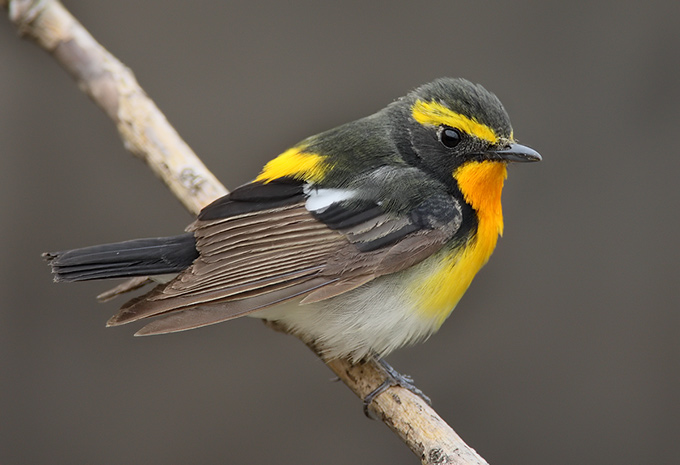
Geum-Eocheong Island, April 21
Following several days of VERY intensive shorebird counting, a couple of days birding on Eocheong through a forecast rainy spell and until tides improve. At the Geum Barrage, more than 5000 Dunlin and the Pied Avocet still, while from the ferry, best were 10-20 Streaked Shearwater and 2 loons (one of which was a Red-throated). On Eocheong itself, decent (though unexceptional) numbers of a wide range of commoner species, with e.g. 15 White's Thrush, 7+ Blue-and-White Flycatcher and 30 Black-faced Bunting, allowing over 100 species to be logged for the day (with 70 on Eocheong and a further 30 at the Geum and at sea). Taxa of most note on Eocheong were a baicalensis White Wagtail (very scarcely recorded in Korea) and a male Narcissus Flycatcher showing some greenish mantle tones, while outstanding highlight was a Saker Falcon (Eocheong's first) seen flying over the Yangji Minbak by Nial Moores and Robin Newlin.
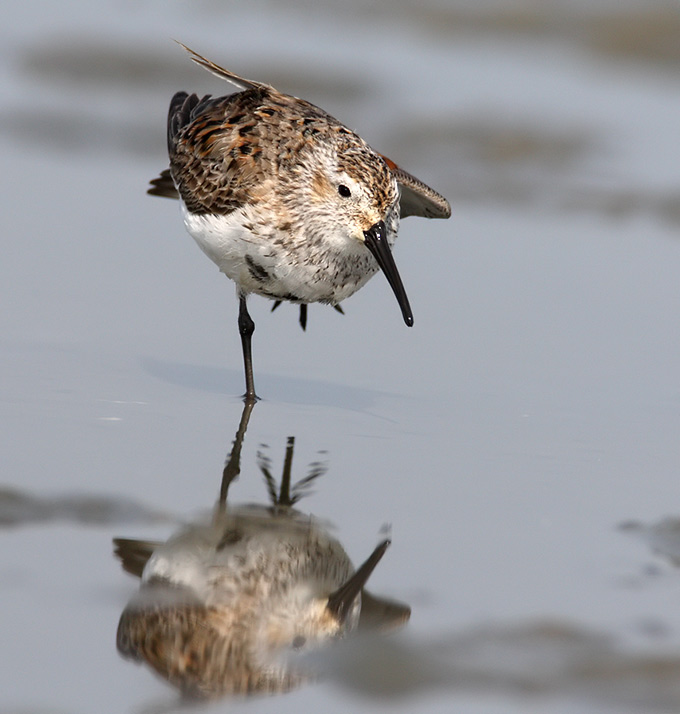
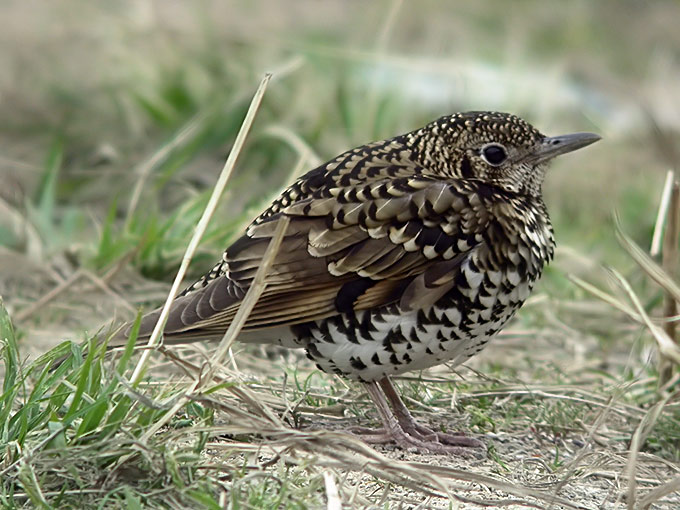
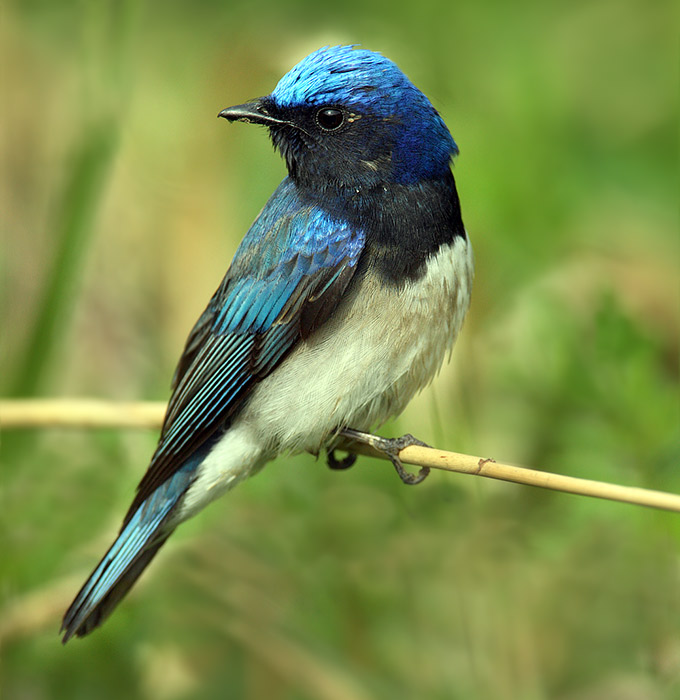
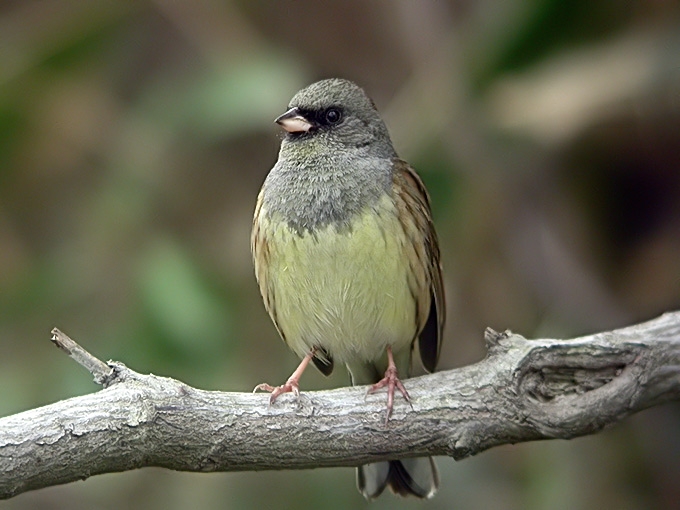
Lake Park and Jeongbalsan, Ilsan, April 20
On a hot and sunny day in Lake Park, a pair of Mandarin Ducks (a personal first for Ilsan) stayed in the centre of the ‘lake’ for a few hours with the usual dozen Spot-billed Ducks, before flying off. A group of about 8 unidentified Sandpipers also passed through the park.
On Jeongbalsan, a clearing held at least a dozen Olive-backed Pipit. Mingling with several White’s and Pale Thrush was a single Grey-backed Thrush. An Eurasian Jay perched in a tree, after being mobbed by several Brown-eared Bulbul. A female Red-flanked Bluetail was also seen.
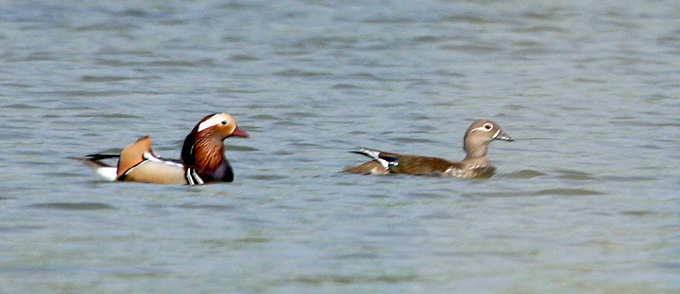
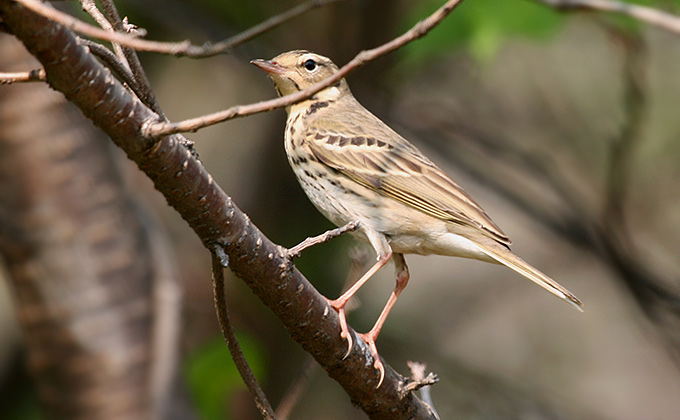
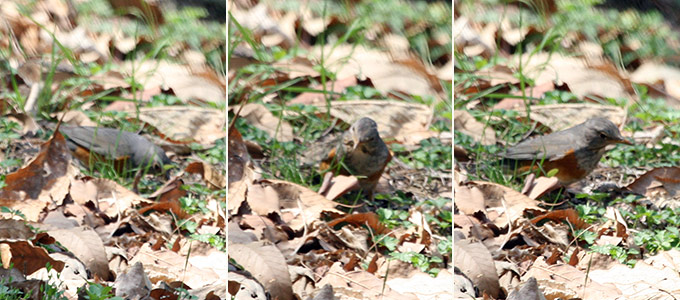
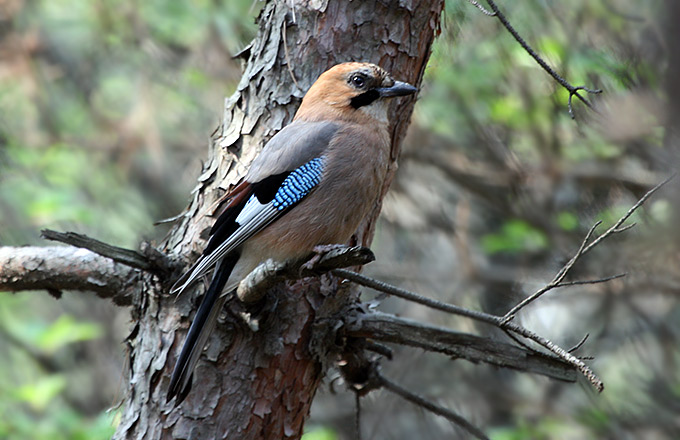
Oido, April 20
The Shiwhabang-jo-jeh (Shiwha bridge) now encloses a massive area of former intertidal mud, linking Daebu island to the mainland at both sides. Toits left, the large created shiwha lake: to the right, mudflat. With the tide in, I walked 1km past the fence to get a view of the lower reach of the lake by the dam wall. Clearly a lot of saltmarsh and reedswamp remains along its edges, although this is now being developed, and closed off for construction. Nevertheless, a shorebird roost was present, which held 400+ Dunlin, 130 Bar-tailed Godwit, 110 Far Eastern Curlew, c.50 Grey Plover, 40 Kentish Plover, 15 Whimbrel, 2 Eastern Oystercatcher and 1 Eurasian Curlew. Along the fence, large promotional billboards simultaneously show spoonbill and wildfowl flocks, as well as the envisioned future- a new city concreted and paved to the edge of one side of the lake (apparently minus the reedbeds).
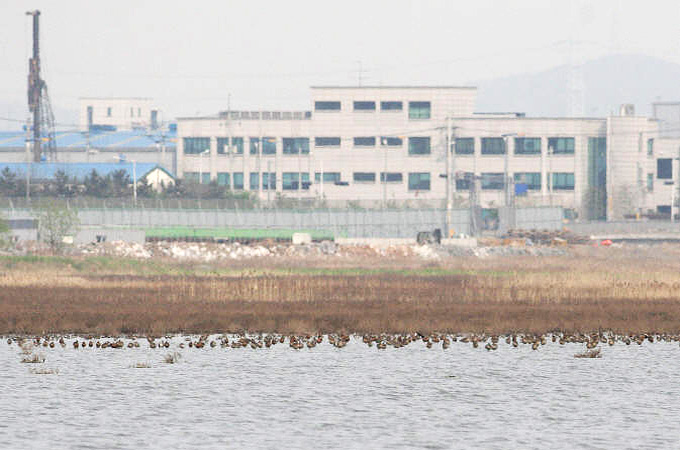
South Saemangeum and Gomso Bay, Second Count Cycle Day 3, April 20
The last day of counts for this cycle recorded 24,270 shorebirds inside Saemangeum, the majority of which (13,023) were found during the boat survey of the inner Saemangeum system. The Inner river areas continued to be more productive for shorebirds than the outer sites, as the Inner Dongjin held 6,608 shorebirds. All sites from Gye-hwa to the southern seawall held 4,631.
Dunlin (11,290) were again the most numerous, while a larger number of Great Knot (10,892) were found. Whimbrel have risen to 174 while 1,161 Bar-tailed Godwits were also recorded. The boat survey of Saemangeum led to interesting discoveries on the southern most island just inside the sea wall. As the counters landed and over the next hour, over 4,000 Great Knot were seen flying into the system from the area just outside the Southern portion of the sea wall. This same behaviour was witnessed last count cycle though at a different stage in the tide. This will be monitored closely in the next count cycle. Water quality on the outer islands seemed reasonable, though inner sites like Simpo Island showed murky water and evidence of yellowish or pinkish foam washed up on the waterline.
Gomso Bay held many more birds than in the First Count Cycle, with 3,031 being counted, compared to just 345 last cycle. The most numerous species were Dunlin (1,243), Great Knot (820), Whimbrel (584) and Bar-tailed Godwit(145). The highest count of Terek Sandpipers was also recorded with 119 being found.
Both the Inner Mangyeung and Inner Dongjin Rivers held more shorebirds than any of the other sites within Saemangeum. As time wears on and the sluice gates continue to halt the tide from entering Saemangeum fully, it seems the river-side sites have become the favoured target for foraging shorebirds. It will be interesting to see if this trend continues into the Third Count Cycle, set to begin on May 5th.
North Saemangeum and Mangyeung River, Second Count Cycle Day 2, April 19
Teams moved into Saemangeum today for the second day of counting in this cycle. The Airport, Haje, Okgu, Hwapo and Simpo were all covered, while Shellfish Harbour was counted for a second time.
The Saemangeum sites held 21,756 shorebirds, the most numerous being Dunlin (14,702), Bar-tailed Godwit (2,175) and Great Knot (1,568). 2 Ruff were recorded at Hwapo East. The Inner River area of Hwapo held the most birds, with 7,334 birds being counted between the three count areas. Okgu was next productive with 5,469 shorebirds while Simpo had 4,381 and the Airport sites held 4,032.
The second count of Shellfish Harbour produced a total of 16,254 shorebirds. Bar-tailed Godwit (7,034) were the most numerous while Great Knot (4,104) and Dunlin (1,550) were also well represented. The counts here were highlighted by a single Black-winged Stilt, breeding plumage Chinese Egret and 5 Nordmann's Greenshank.
Tomorrow the focus shifts to the southern Saemangeum sites, including a boat-based survery of the inner Saemangeum area. Thanks to Robin Newlin for joining the team today and for Birds Korea National Coordinator Ms. Park Meena for coming over from Busan with volunteer Ms. Kim Bo-ram.
Gwangyang Bay, April 19
Access to the better mudflats in Gwangyang Bay is a little difficult, but the whole area does seem to be a staging ground for a few species (albeit in lower numbers than the main sites). Apart from Dunlin in the low hundreds, there were 35 Whimbrel and a scattering of other species including one Pacific Golden Plover and 1 Ruddy Turnstone. The area seems to hold potential for 'better' species and should be watched a little more closely.
In fields nearby I saw a good mix of birds including 2 Little Bunting, a trio of Siberian Stonechat and 2 Common Snipe.
The only amphibian of the day was Oriental Fire-bellied Toad (Bombina orientalis).
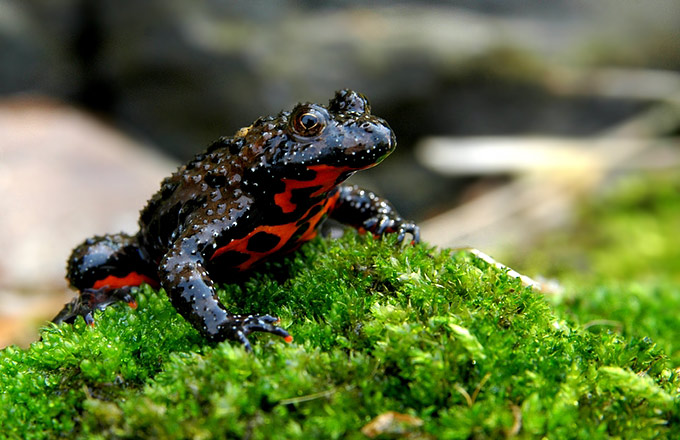
Geum Estuary, Second Count Cycle Day 1, April 18
9 volunteers and 2 reporters from Hangyoreh newspaper visited the main roost sites of the Geum Estuary to kick off the Second Count Cycle of this year's SSMP. A weak 6-meter tide produced interesting results, with a total of 49,028 shorebirds being counted by the team today. Almost half of those were counted on Yubu Island, where 27,131 shorebirds were found.
The most numerous birds were 23,159 Dunlin, 9,517 Bar-tailed Godwit and 8,860 Great Knot. A few species were greatly increased from the last Count Cycle, including 274 Terek Sandpiper, 152 Whimbrel and 130 Ruddy Turnstone. The Pied Avocet seen April 17th was not found again, while Spotted Redshanks peaked at the Geum Barrage with 117 present.
Tomorrow the team will move into the Northern Saemangeum sites, including the Airport, Haje, Okgu and Simpo. We would like to thank the volunteers from Gunsan for joining us today at the Geum Barrage and Shellfish Harbour.
Geum Estuary, April 16
On a weak spring tide, more notable species at the Geum barrage included at least two Curlew Sandpiper, three Ruff, now 33 Sharp-tailed Sandpiper, probably 10 Pacific Golden Plover, and 77 Spotted Redshank, while the flats at shellfish harbor held c 5000 Great Knot, and best of all at least 11 or 12 Nordmann's Greenshank - the first of the 2008 SSMP.
Gangwon coast from Sokcho to Goejin, April 13
On April 13 I travelled north from Sokcho along the coast to Geojin with Kim Seong-mi and Park Gyeong-sim. There were many Great-Crested Grebes, Black-tailed Gulls, Vega Gulls and some Slaty-backed Gulls in various places along the coast. We saw numerous Red-breasted Mergansers and Sanderlings as well. A pair of Harlequin Ducks on the north side of Munam harbour. A Peregrine Falcon was seen sitting on a rocky islet near the coast. South of Geojin we saw 2 male Common Scoters and several Red-throated Loons. On one of the beaches we saw Little Ringed Plovers and a Kentish Plover. On the beach at Geojin we had excellent views of a Far Eastern Curlew. In various places along the coast there were many cormorants, including Temminck's Cormorants and Pelagic Shag sitting on rocks on the north side of Geojin. We also visited Hwajinpo Lake and saw several hundred Tufted Ducks. Other water birds included seven Garganey, Mandarin Ducks, Little Grebes, 2 Baikal Teal, Spot-billed Ducks, Greater Scaups, Mallards, Common Goldeneyes, Pintails, Pochards and Common Teals.
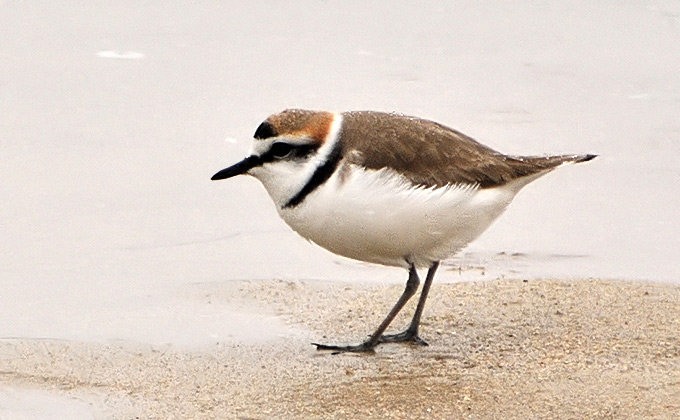
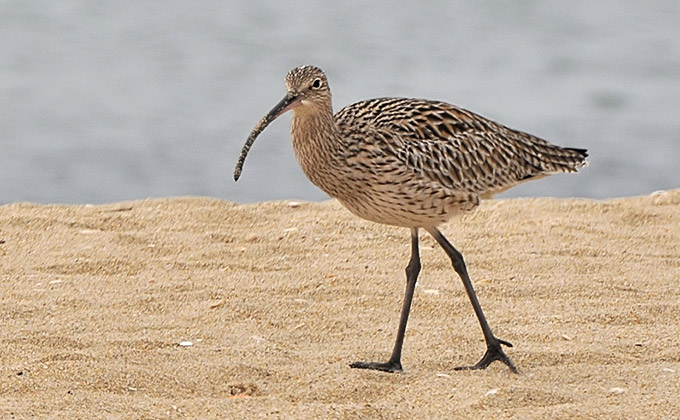
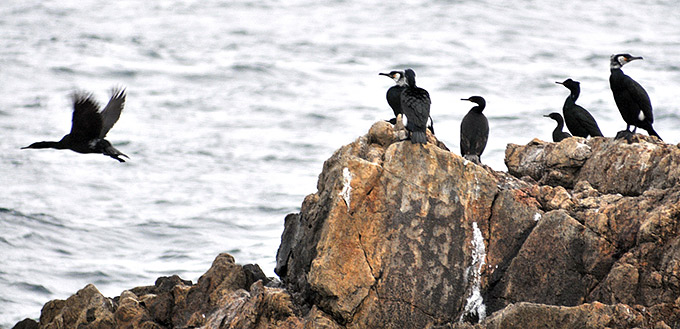
Hemi-chun(creek) Seosan, April 12
I spent 2 hours in Hemichun-creek in Seosan in the cloudy but warm afternoon looking for waders used to be in fresh water. Species are not many. But highlights were a male Ruff, 5 Sharp-tailed Sandpiper, a Marsh Sandpiper, a Common Greenshank, and 2 Green Sandpipers. Among ducks, Common Teals are the most abundant species and next are Spot-billed and Mallard. 2 Garganey, certain numbers of Wigeon, Falcated Teal, Northern Shoveler, Common Shelduck, and Gadwall were seen. In the dry rice-field between Hemichun-creek and air-base, 23 Hooded Crane and 15 White-fronted Goose were also found.
Choengcho Lagoon, April 12
I made a brief visit to Cheongcho Lagoon and I was rewarded with three unusual birds. With the Great Cormorants and gulls on the sand bank, there was a Black-winged Stilt and a Eurasian Oystercatcher, and wading in the water nearby was a Bar-tailed Godwit.
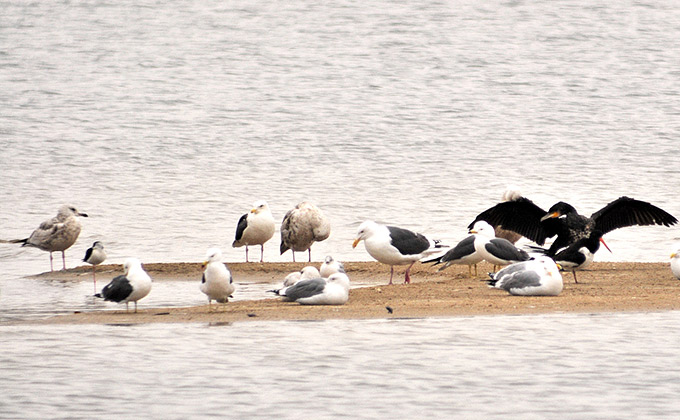
Eastern Oystercatcher Haematopus (ostralegus) osculans (right) Photo © Barry Heinrich
Taejongdae, April 12
The weather was less than perfect in the park but four hours was enough to give us an idea of what birds were around. Along a creek we found a lone Japanese Robin and not long after, the first of 3 Grey Thrush. Along the road, Japanese White-eyes were active in the Cherry blossoms, as was a Narcissus Flycatcher. Overhead were two Black Kite. Perhaps a trip in a couple of days will turn up more, if anyone is nearby.
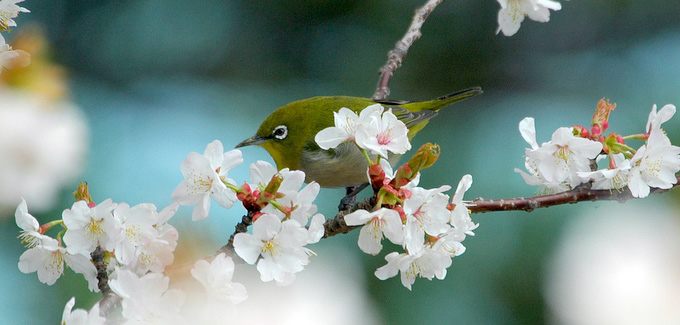
Songdo, April 12
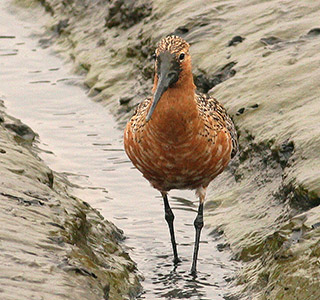
The long-staying Pied Avocet (since Nov.12th 2006) was still present in the brackish area, while bulldozers closed off the section of water behind it. Nearby, 4 Garganey included 2 prettily striped males. Overhead 2 Common Tern - (an unusual sight here), also 53 roosting Ruddy Shelduck, 24 Gadwall, 2 Wigeon and various other typical anatidae. With the tide far out on the remnant mudflat, proper counting impossible, but 400+ Bar-tailed Godwit, 60 Eurasian and 1 Far Eastern Curlew, perhaps 80 Grey and 5 Kentish Plover, 20 Dunlin, 4 Eastern Oystercatcher, a Common Sandpiper and c. 40 Saunders's Gull within view. Despite a new road being constructed through the middle of the lagoon, a handful of Little Ringed Plovers, 14 Common Greenshank and the resident Peregrine looked on: in trees beside, 9 Olive-backed Pipit and 4 lingering Dusky Thrushes.
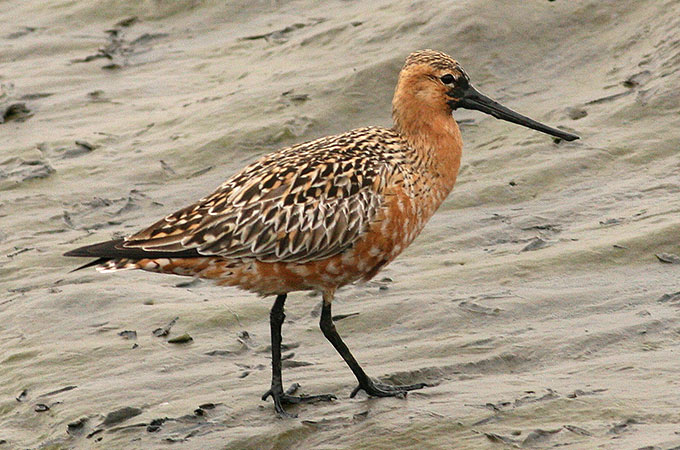
Jeongbalsan, Ilsan, April 12
On a pleasant overcast and warm day, a large flock of about 40 Black-crowned Night Heron were circling over the mountain and settling noisily into the tree tops in smaller groups. A small blue bird was seen from afar and poorly photographed - I convinced myself it was a Hill Blue Flycatcher, until later study of the blurry pictures revealed the white chin and throat that identified it as a male Red-flanked Bluetail. The White’s Thrush invasion has hit Ilsan, with about two dozen seen on the mountain, pulling worms out of the ground. Several Pale and Dusky Thrush were also seen associating with the White’s Thrush. Some Brown-eared Bulbul were feeding on bees and wasps in blossoming trees. Other birds seen include several Vinous-throated Parrotbill, Goldcrest, Japanese Pygmy, Great-spotted, and Grey-headed Woodpecker, and plentiful Great, Varied, Long-tailed and Marsh Tit. Several Pheasant were heard but not seen. A Chipmunk was also seen busily feeding.
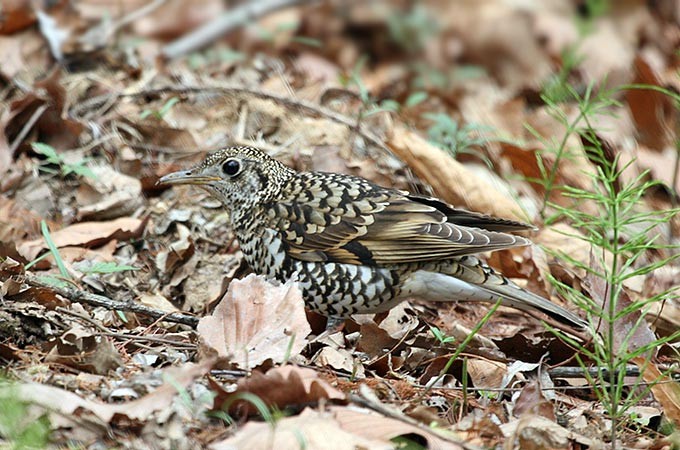
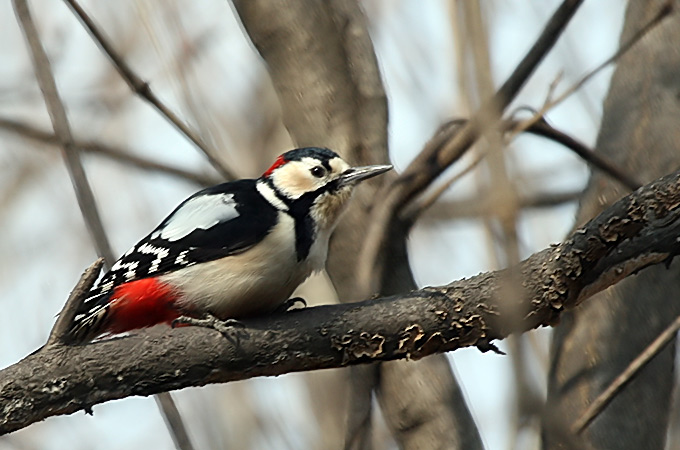
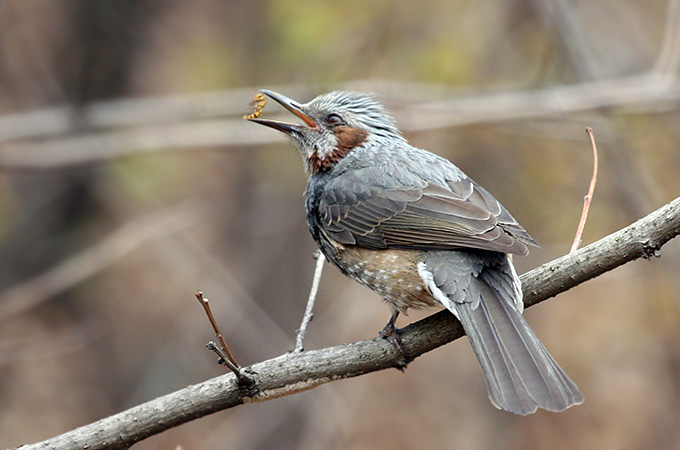
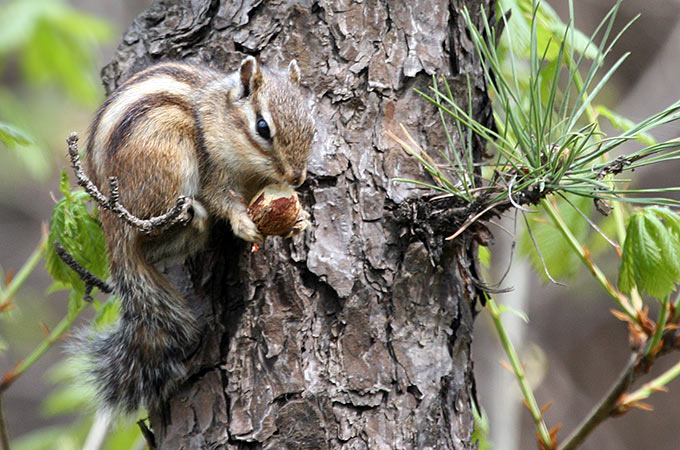
Eocheong island, April 10
Overnight rain ending at 5 am was followed by a clear, windy day. By the afternoon, many of birds had cleared out, leaving for example only c.800 Brambling, 8 Rustic Bunting and 4 Red-flanked Bluetail from yesterday's totals. A good mix of species with some new arrivals still led to a total of 69 species.
New birds in were 1 male Garganey (first record for Eocheong island) with 7 Teal, 2 Peregrine Falcon, 2 Grey-faced Buzzard and 1 Japanese Lesser Sparrowhawk. New passerine migrants were 1 Eastern Crowned Warbler, 3 Blue-and-White Flycatcher, 1-2 Narcissus Flycatcher and 1 Red-billed Starling. 40 Siskin were seen in one flock.
Around the reservoir, 2 Striated Heron and 2 Black-crowned Night Heron were seen, while the harbour held 1 Grey Plover, likely only the second record for Eocheong island.
Birds still present from yesterday were 30 White-cheeked Starling, 2 Brown-headed Thrush, 1 Greater Short-toed Lark and the putative Caspian Gull. The Daurian Jackdaw and 3 Rook seem to have moved on by the afternoon.
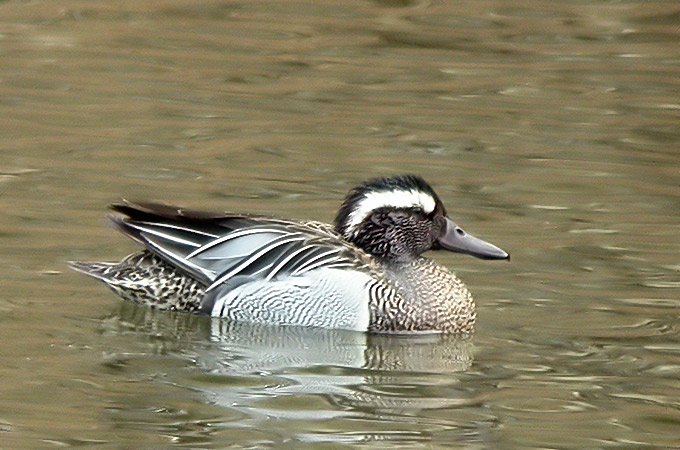
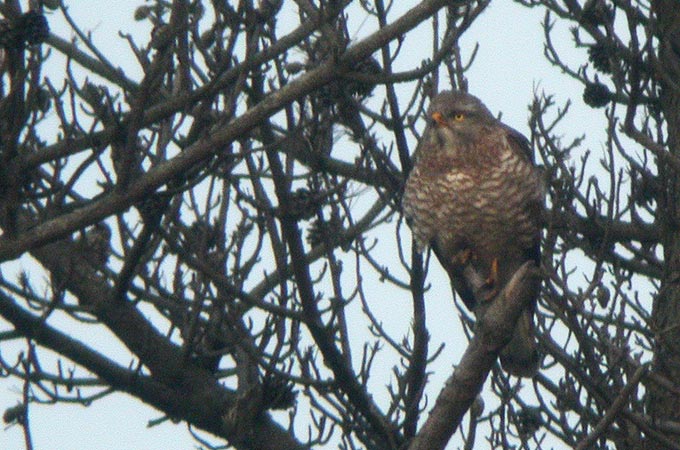
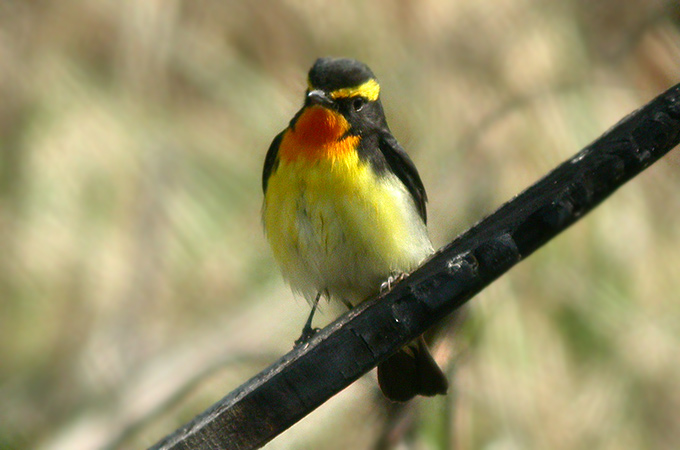
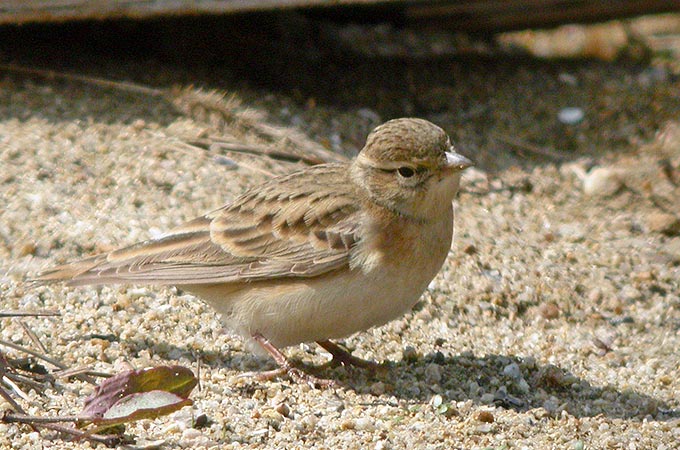
Gunsan to Eocheong island, April 9
Conditions started overcast and cool changing into consistent rain by mid-morning and then heavy rain midday. A break in the rain mid-afternoon was followed by more heavy rain with increased winds. Evidence of a migrant fall led to a mix of late winter species and a few early spring species, with 68 species recorded in total.
The highlight of the ferry journey by 21 Streaked Shearwater and 2 Common Tern. One Great Knot in flight and 10 Garganey were surprises, the latter species being recorded for the first time from the ferry by NM.
The island itself held good numbers of birds and an interesting mix of species. 1,200 Brambling were the most numerous while good numbers of White-cheeked Starling (40), Rustic Bunting (30), Siberian Stonechat (20), Red-flanked Bluetail (15) and Dusky Thrush (15) were also recorded.
Other species of note included 1 Greater Short-toed Lark, 1 Eye-browed Thrush (very early), 2 Brown-headed Thrush, 1 Red-throated Pipit, 1 Daurian Jackdaw with 3 Rook, 1 Siberian Accentor and 2 Pallas' Reed Bunting.
The putative Caspian Gull first seen by NM on April 1st was still in the harbour. More shorebirds were found on the island with 2 Kentish Plover, 2 Little Ringed Plover, 1 Common Sandpiper and 2 Wood Sandpiper. After sunset, Black-winged Stilts were heard over the harbour.
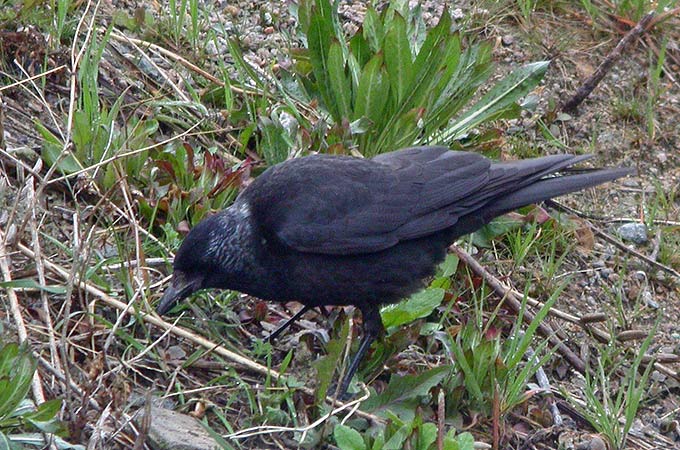
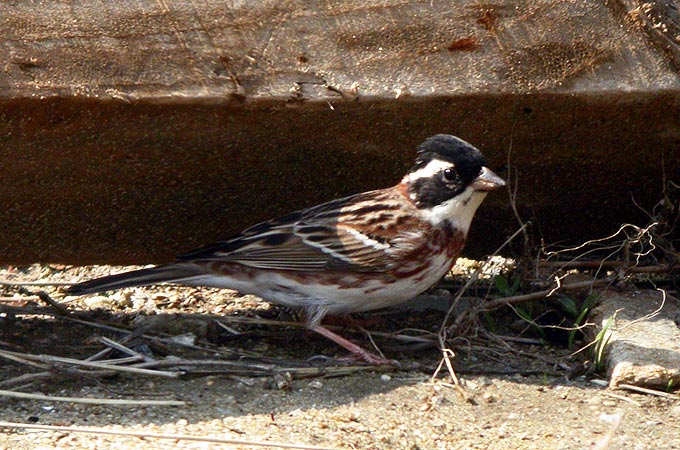
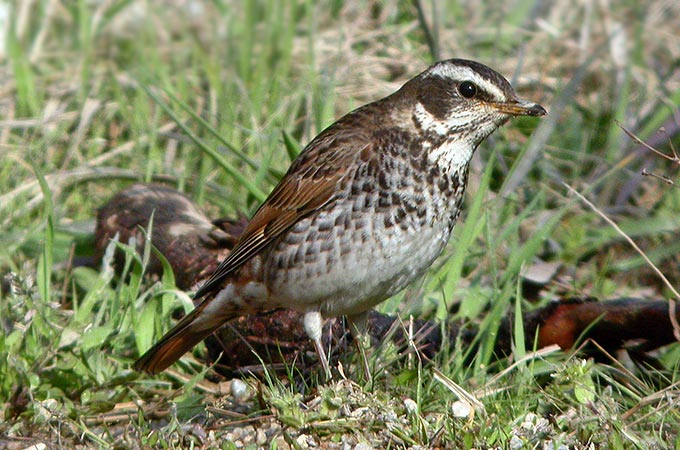
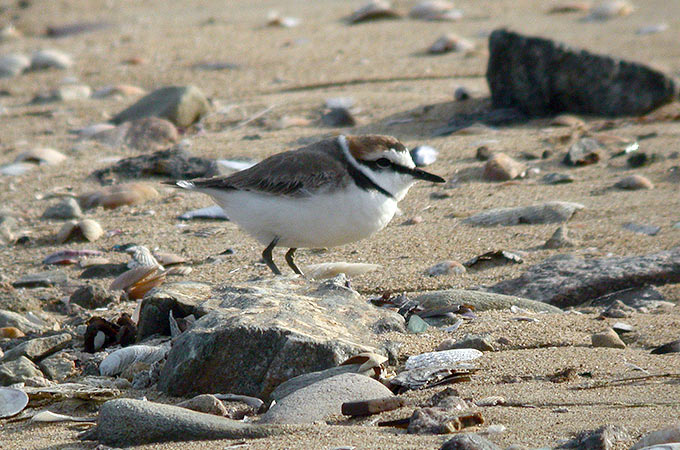
Saemangeum, April 7/8
The last two days of the first SSMP count cycle were focused on the southern reaches of Saemangeum. Between Gyehwa-do and the southern portion of the sea wall, not many shorebirds were counted, although the Southern Dongjin held one small flock of 13 different species, including a Pacific Golden Plover and scarcest of all a breeding-plumaged Pectoral Sandpiper.
On the 7th, while one team counted the Northern Mangyeung (turning up an early Whimbrel and full breeding plumage Mongolian Plover), the other team headed off into Saemangeum on a boat to count shorebirds on the inner islands.
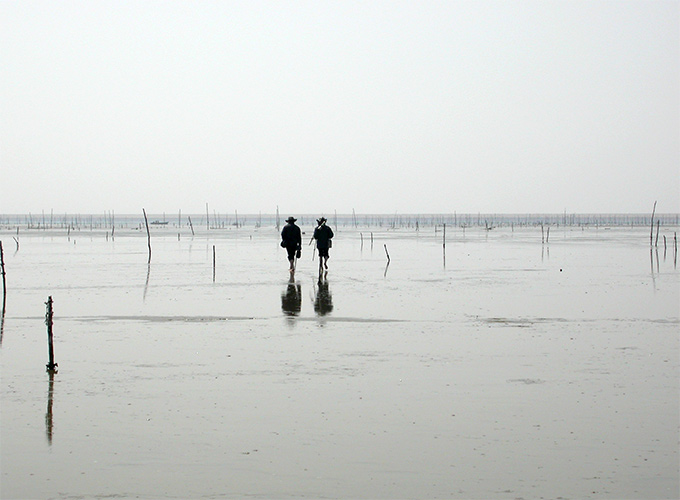
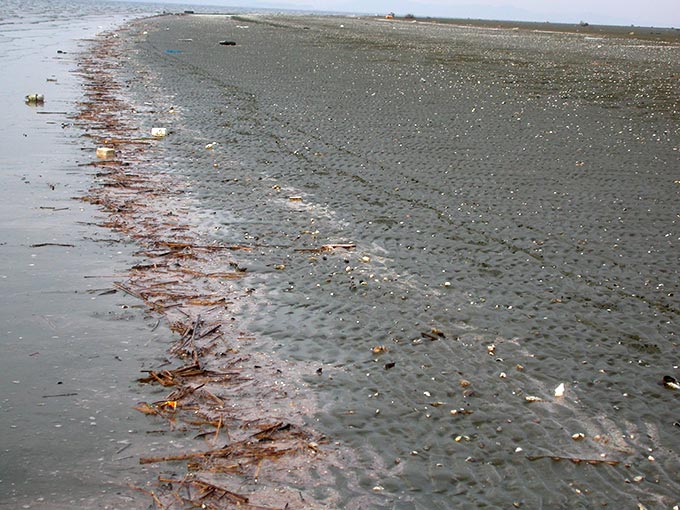
A dispiriting number of shorebirds were seen in Saemangeum by both teams, as well as a general lack of shellfish. An individually leg-flagged Great Knot that was spotted outside the seawall (on the 6th) was seen inside the system (on the 7th), possibly trying to feed during high tide. This might indicate that birds in that area are simply not finding enough food within the system, and are resorting to flying out to tidal areas to fatten up. However, the counters also noticed the birds doing a lot of probing, but very little if any actual eating. We were also greeted by massive areas of red algae within the 'lake', as well as evidence of red tide washing up on the island north of Simpo.
On a more positive note, birding highlights on the 6th were a male American Wigeon (barely annual at the national level), photographed just south of Gyehwa-do, and a flock of 12 Black-winged Stilts on Gyehwa Lagoon. On the 7th Common and Spotted Redshank were seen together and a Red-necked Grebe in the Southern portion of Saemangeum.
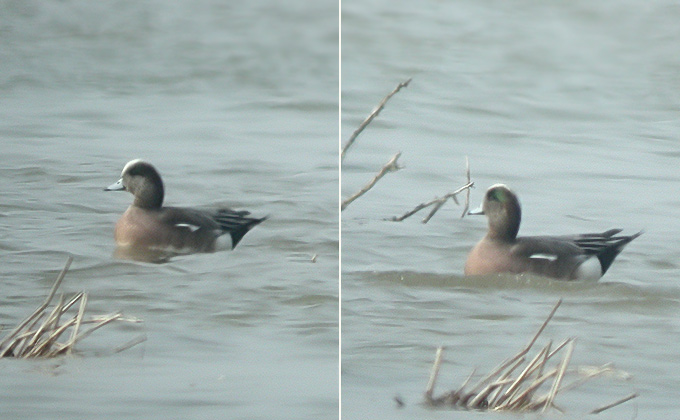
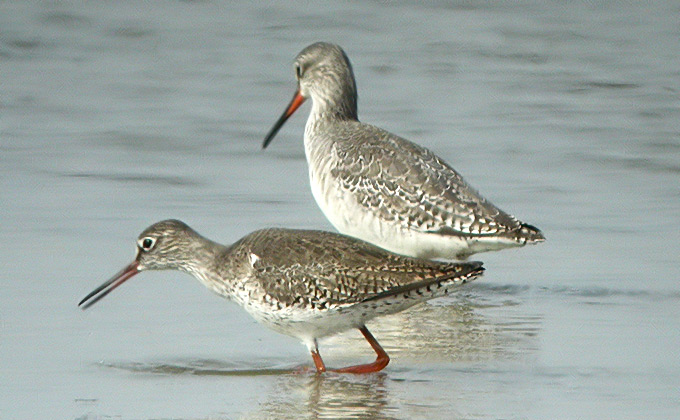
Read the complete SSMP 2008 April 10 Update
Yubu Island, April 6
.
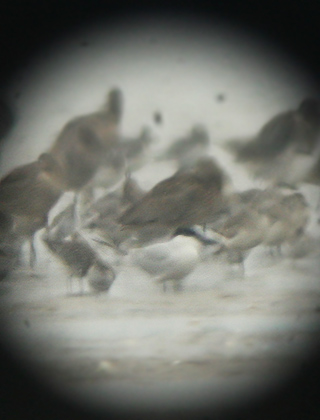
With the biggest tide of the Spring series today, the team packed up and headed off to Yubu Island for what was to be a huge count, as well as three surprise birds and some exciting leg flags to round out the day.
Dunlin dominated at Yubu, with 30,000 birds being counted. Also found in their thousands were: 9,980 Great Knot; 6,635 Bar-tailed Godwit; 4,763 Grey Plover and 2,360 Far Eastern Curlew. Of interest, 58 Sanderling, 2 Ruddy Turnstone, 1 Whimbrel and 81 Saunders's Gulls. The total bird count for Yubu today was 54,165 birds.
Three birds of special interest came in the form of 1 Merlin that put up the flock on the North side of the island, 1 Pied Avocet and 1 Gull-billed Tern, the fifth record for South Korea.
Leg flags were seen from Queensland, Australia (green), Chongmin Dao, China (black/white and white/black), Northwest Australia (yellow) and the datalog Bar-tailed Godwit that we saw yesterday and on the 2nd. After speaking with colleagues in New Zealand, we learned that this bird left Foxton on March 23rd, indicating a maximum flying time of 11 days to reach the Geum Barrage. Also of note was one Bar-tailed Godwit female with a broken satellite antennae that was from the first satellite tracking group from 2 years ago. We presume it to be E0, a bird that used the Geum Barrage to stage last year, which also had the same broken antennae.
Monday and Tuesday will be devoted to the remainder of the sites within Saemangeum, including one day of boat-based counts within the sea wall. Final numbers for the first count cycle will be posted upon completion.
Gomso Bay, Airport, Haje, Okgu, Yubu and Daechuk Islands and Geum sites, April 4-5
Full counts are now underway for the SSMP 2008, with our first international volunteer already landed from Australia. The Gomso count, though quiet shorebird-wise, did have a surprise addition of 60 Hooded Crane, including 15 juvelines.
Inside Saemangeum, counts revealed several thousand birds made up of the usual species. Firsts of the count cycle consisted of single Pacific Golden Plover, Red Knot and Mongolian Plover. There is evidence of c. 10 cm tide within the system, and at the Airport especially a lot of fisherfolk activity with new crab traps, many people digging for shellfish and using small machines to dredge the mud below water line.
The Geum Estuary sites proved interesting as two boats headed out to see what Yubu and Daechuk Islands had to offer, with a minimum of 37,000 birds counted on Yubu and large roosts of both Far Eastern and Eurasian Curlew, both flocks of which were entirely separated over two different islands.
At the Geum Barrage, 2 Sharp-tailed Sandpiper were seen on the rising tide. 9 birds were also spotted with varying leg flags and bands, the colours of which tell us they came from Chongmin Dao, China, both Southwest and Northeast Australia and New Zealand. The next few days will see a second count of Yubu island and about 3 days spent among the Saemangeum sites.
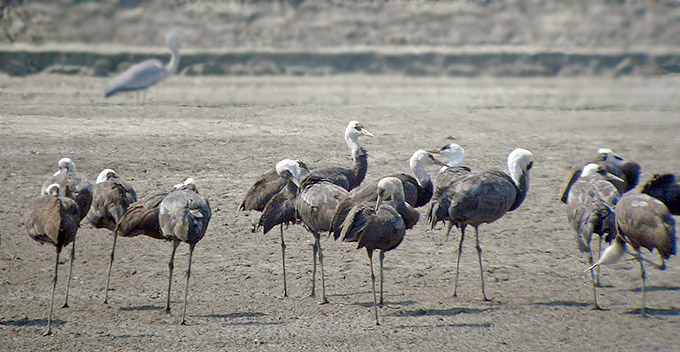
Suncheon and Namhae, April 5
Low numbers present at Suncheon Bay (both in terms of people and birds), but a flock of 8 Oriental Plover made for a successful trip. Also present were singing Pallas's Reed Bunting's coming into breeding plumage, as well as very good numbers of Common Shelduck and a few Chinese Penduline Tit. On the reptile front, we saw a Dione Ratsnake.
At Namhae we enjoyed fantastic views of Finless Porpoise at their usual spot - watched from the bridge above while they were catching fish.
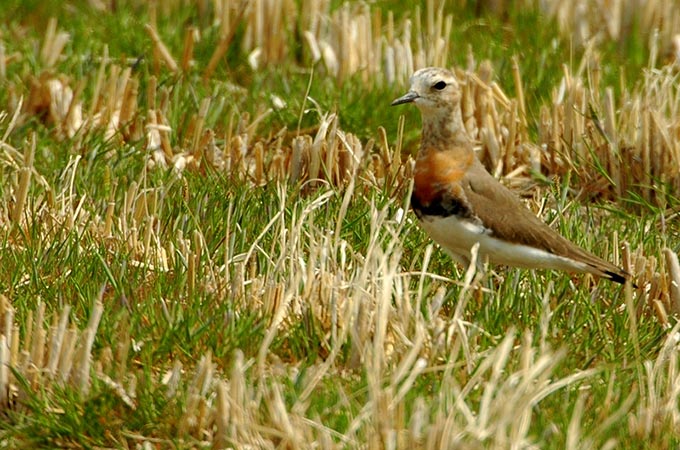
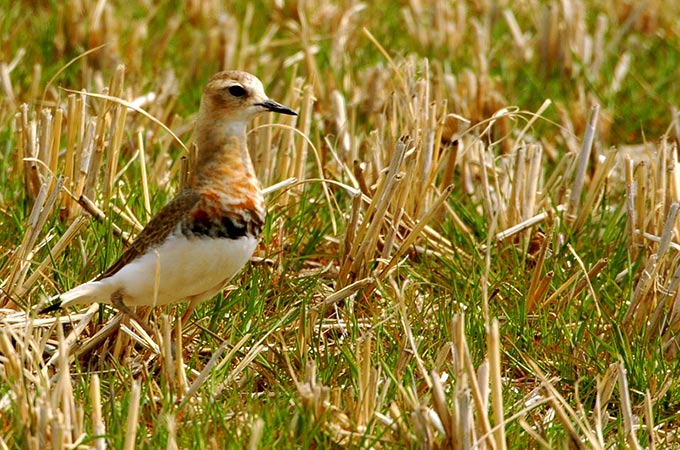
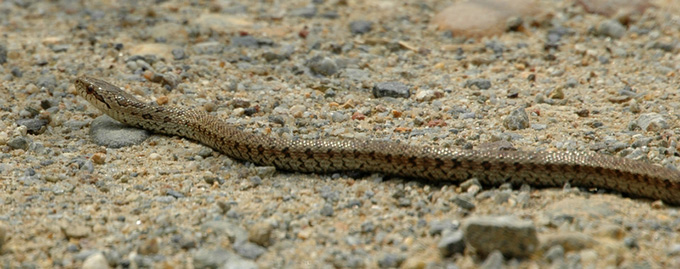
Uiwang, April 4
A short afternoon trip to Uiwang's lake and ricefields in warm bright weather. Most of the waterfowl have headed off north, but a few Tufted Ducks, Pintails, and Common Teal remained along with the Spot-billed Ducks and Mallards; these were joined by a few Great-crested Grebes, Northern Shovelers, Coots, 2 handsome Garganey and a distant Little Tern. In the rice fields, 3 Snipe showing just their heads; later, another seen flying appeared to be a Pintail Snipe. A White Wagtail, 2 Little Ringed Plovers, a couple of Swallows, many Vinous-throated Parrotbills, various Rustic and Yellow-throated Buntings, and 5 White-cheeked Starlings completed the picture.
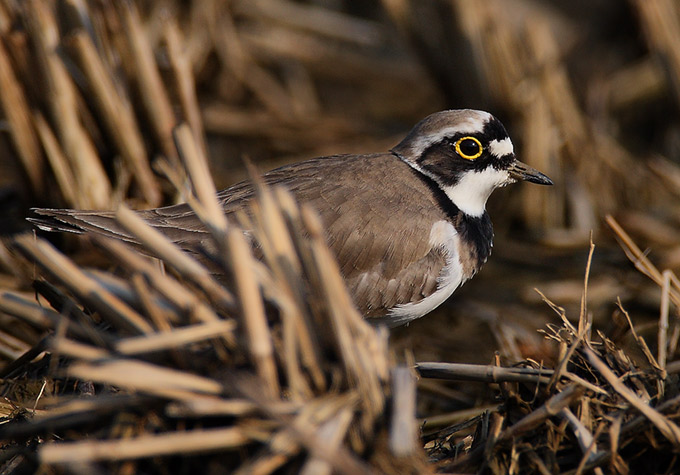
Shellfish Harbour, April 3
As the tides rise into Spring heights, numbers of shorebirds are increasing in each site. At Shellfish this afternoon, we counted 1291 Dunlin, 1200 Bar-tailed Godwit, 791 Great Knot, 599 Far Eastern Curlew, 33 Kentish Plover, 17 Eurasian Curlew and 6 Common Greenshank. At the Geum Barrage earlier, Grey Plover rose to 10 while the number of Spotted Redshank have increased to 22. Also at the Barrage was one Little Ringed Plover, a species that we have not seen often at this site.
Our first international volunteer has arrived, and the first count cycle for the Saemangeum Shorebird Monitoring Program begins tomorrow at Gomso Bay and in Saemangeum. Updates about the counts will be posted regularly throughout the two months, and volunteers are most welcome. If you are interested, please email Birds Korea to organize a date and time.
Eocheong Island-Gunsan, April 3
Beautiful weather (sunny, light southwesterly wind and mild, with a high of c 14 C), good birds, but very noisy today, with construction work in the harbor.
Of the 50 or so species logged before the return ferry, best were the putative Caspian Gull, the teal (though seen only very distantly) and the male Pine Bunting again, with new arrivals including an Intermediate Egret and greatly increased numbers of Great (50+) and Coal (30+) Tits. From the ferry, only one Streaked Shearwater, 7 distant egrets (probably Intermediate) and a distant accipiter north.
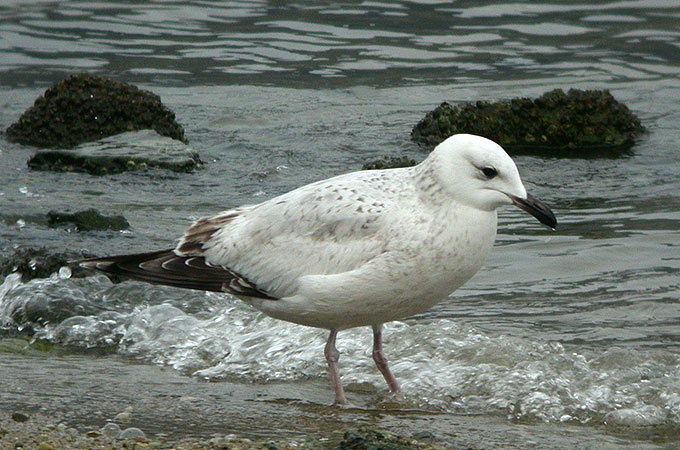
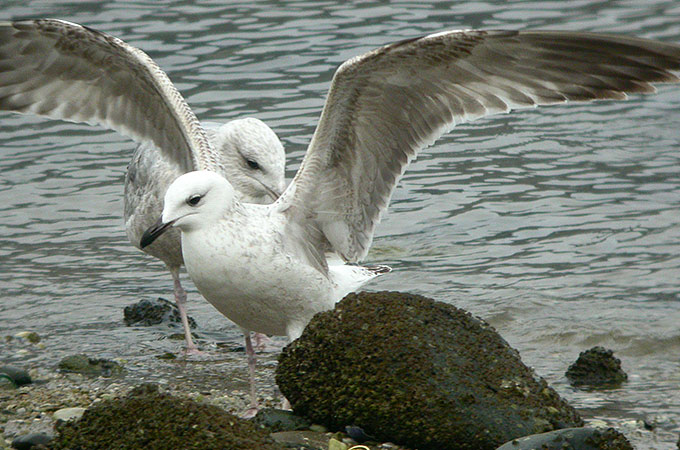
Geum Barrage, Airport, Haje and Okgu, April 2
On a rising tide at the Geum, 984 Bar-tailed Godwit with now 9 Grey Plover, and the season's first Terek Sandpiper. The Black-tailed Godwit was spotted again, and a Common Sandpiper was seen among the gulls. A bit of excitement ensued when we saw one of the Bar-tailed Godwits that has been datalogged (see photo). These datalogs were put on in New Zealand, and through tracking daylight hours, help the catchers learn about the birds' migration, though they must be re-caught next year in New Zealand in order to retrieve the datalog. Keep your eyes out for these birds, and if you see one in your area, please email Birds Korea with the place, time and band colour information.
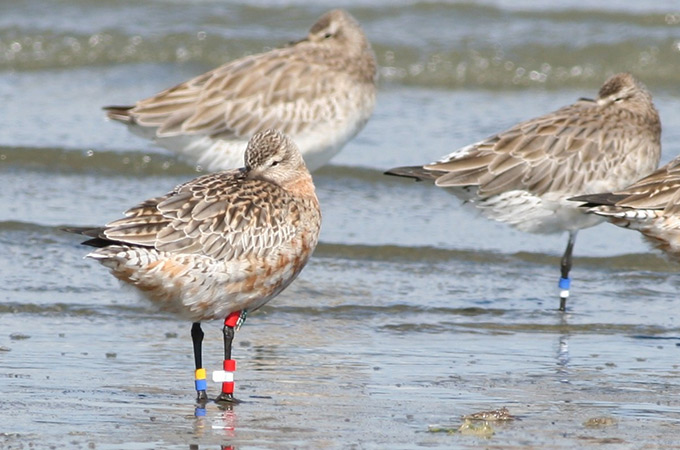
Our first foray into Saemangeum produced a surprising number of birds at the Airport, with c. 2,000 Dunlin, c. 400 Great Knot and healthy numbers of Kentish and Grey Plover, and both species of Curlew. Haje was very quiet with only a handful of Eastern Oystercatcher and Curlew. Okgu held more ducks than anything else near the corner, with one raft of 200 ducks being split fairly equally between Pochard and Tufted Duck.
In all three sites, the amount of weeds and bushes evident was very surprising, as these 10,000 year old tidal flats are slowly forced into converting to this arid shrubland. There was some evidence, especially at the Airport, of a small movement of the waterline within the Saemangeum system, but it would have been mere centimeters. Working towards keeping the sluice gates open in the sea wall becomes more and more important as the days progress and the old tidal flats lose their ability to support life.
Eocheong Island, April 2
Cloudy overnight with a brief spell of rain before becoming windy and cold, then calmer, clearer and milder again by evening. Fifty-three species logged during the day, including the putative Caspian Gull (frequently harrassed by other gulls), single Red-billed Starling and Chinese Blackbird again, greatly reduced numbers of some migrants (e.g. only 40 Siberian Stonechat), and some increase in finches and buntings, with e.g. 150+ Eurasian Siskin, 5 Bullfinch, 7 Little and a single Pallas's Reed Bunting. Lots of interest through the day, with best a confiding male Pine Bunting (presumably of subspecies fronto, as was a male here on March 25th 2003, based on the very broad black on the crown sides and forehead, and the intensely saturated plumage: most checklists suggest the subspecies occurring, very scarcely, in Korea should be nominate), and in the evening a female teal showing characters of Green-winged Teal (i.e. a very prominent pale loral spot recalling Blue-winged Teal, even well-visible in flight, and very weak trace of a second lower face bar under a very well-defined dark eye-stripe. Unfortunately, it flew off into the bay before any images could be taken).
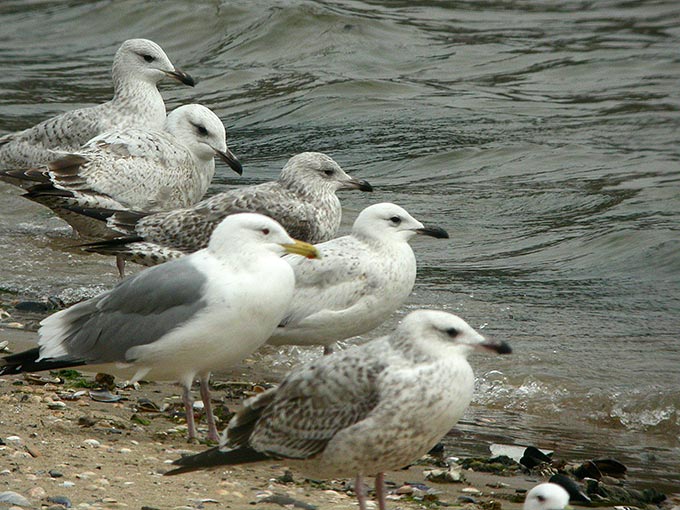
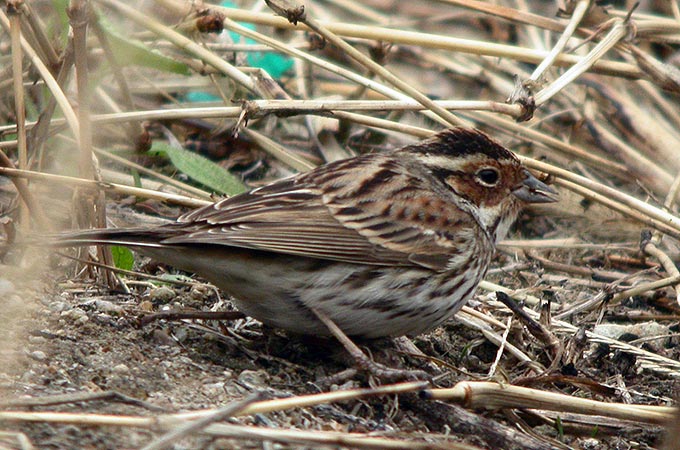
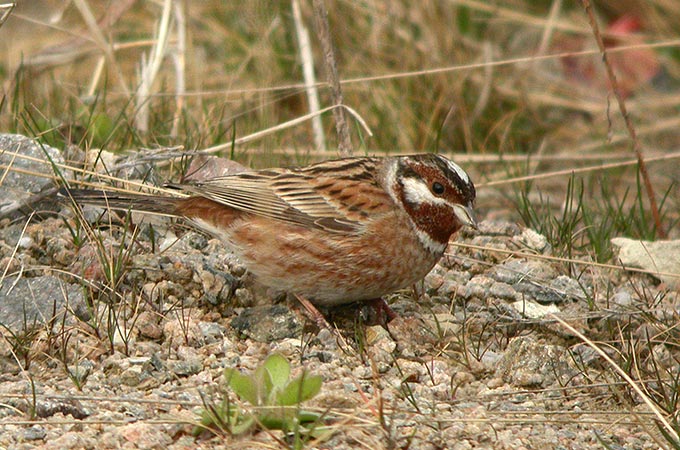
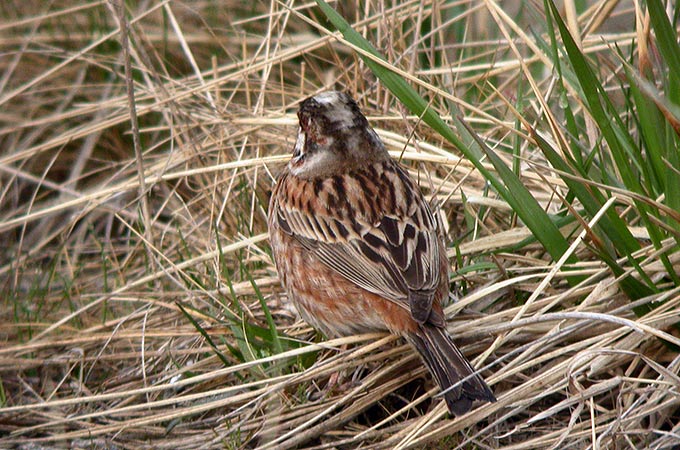
Gunsan-Eocheong Island, April 1
In fairly warm sunshine (with a high of 12 C on Eocheong) a quick, pre-SSMP trip out to Eocheong. From the ferry 10 Streaked Shearwater, and three murrelets in a tight group, briefly alongside and then across in front of the boat. The first was a breeding-plumaged Ancient, the second a more intermediate plumaged Ancient, and the third showed a prominent white brow, and more importantly solid black from the bill base back to the flanks, lacking any kind of white "shoulder" indent: Crested Murrelet! Sadly, the brevity of the view meant there was no time to see any other diagnostic features.
On the island itself decent numbers of migrants, with presumably many of these left over from the rain and wind of the previous three days. Most numerous were Siberian Stonechat (105), Yellow-throated Bunting (75), leucopsis White Wagtail (40), Eurasian Siskin (40), Daurian Redstart (25), and Red-flanked Bluetail (20), while other early typical spring migrants included 8 Hoopoe and single Red-billed Starling and Chinese Blackbird. Less expected were 7 Siberian Accentor and 4 Black-winged Stilt, while highlight was a putative Caspian Gull - extraordinarly bleached, but showing several characters in combination that seemed out of the range for either Mongolian or e.g. barabensis. Positive features included its small size, long bill (only slightly paler at the base), white-headed ness (with contrasting hind-nape shawl), fine anchor-shaped marks on the scapulars (typically much coarser in other large gulls here), and upperwing and uppertail pattern. Comments from those with experience of these taxa much appreciated!
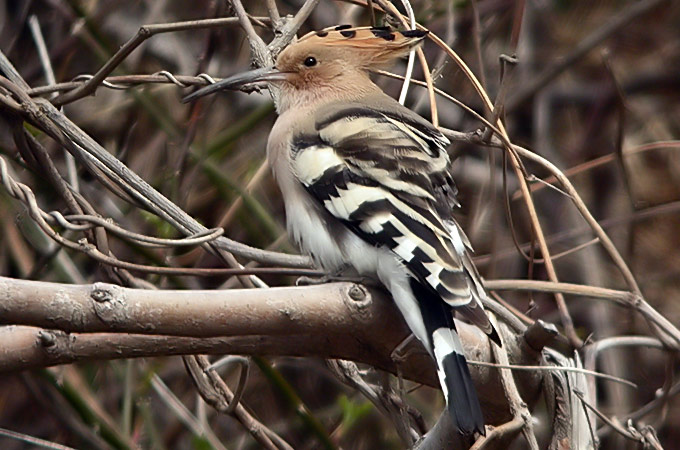
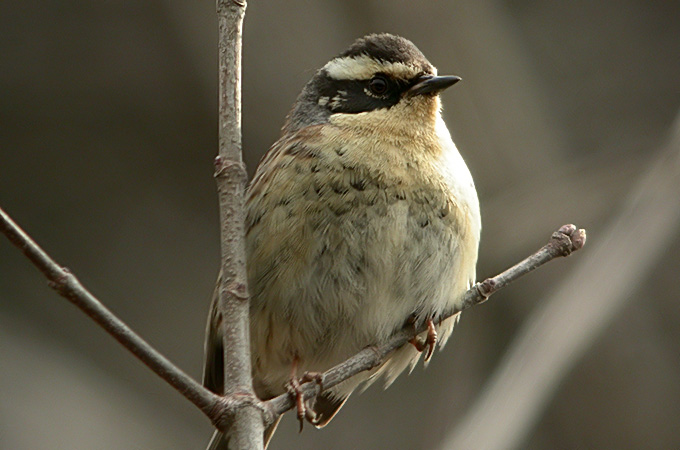
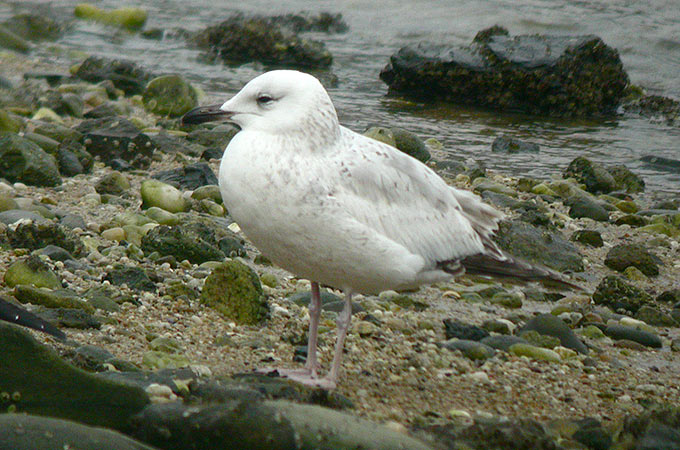
Geum Estuary sites, April 1
A brief look at the SSMP count sites in the Geum Estuary proved interesting in a number of places. Little Ringed Plover were seen in their usual spot at Wulpo, while up at Jang-gu Bay south, 399 Eastern Oystercatchers followed the rising tide joined by a smattering of Eurasian and Far Eastern Curlew, Bar-tailed Godwit and Dunlin. In the forest nearby were Ring-necked Pheasants, a small flock of high-pitched Goldcrest and a Japanese Pygmy Woodpecker. The biggest surprise came from a group of 20 Swan Goose, including one necked-banded R05.
Counts at the Geum Barrage yielded 3367 Dunlin, 661 Bar-tailed Godwit, 198 Eurasian and 37 Far Eastern Curlew, 7 Spotted Redshank, 4 Grey Plover, 2 Eastern Oystercatcher and Kentish Plover and one Black-tailed Godwit. More counts will be conducted over the next two days, including early looks at Saemangeum sites ahead of full SSMP counts starting up this Friday April 4th.
Eulsukdo, April 1
A rare weekday without having to teach gave me a birding opportunity, so I returned to Eulsukdo, where I had good birding on Saturday. My decision proved to be a good one, because I found a Black-faced Spoonbill foraging in the extensive mud flats in the northwest corner of the sanctuary. This is probably the same individual I found there last Saturday, which I did not post, in part because I was unable to confirm its identification to species. Today, I saw it well and close enough to make the identification certain. After reporting it to the staff at The Eco Center, I was told that there were four spoonbills seen on Sunday, one of which they felt "might have been a Black-faced." Unfortunately, I didn't find too much else of note other than a female Common Kingfisher, a flock of about 70 White-cheeked Starlings, and 4 Japanese Quail. Remarkably, I could not find a single shorebird, even though there were dozens of Little Ringed Plovers there 3 days ago. I also found my first Korean reptile: a Wolter Lizard.





